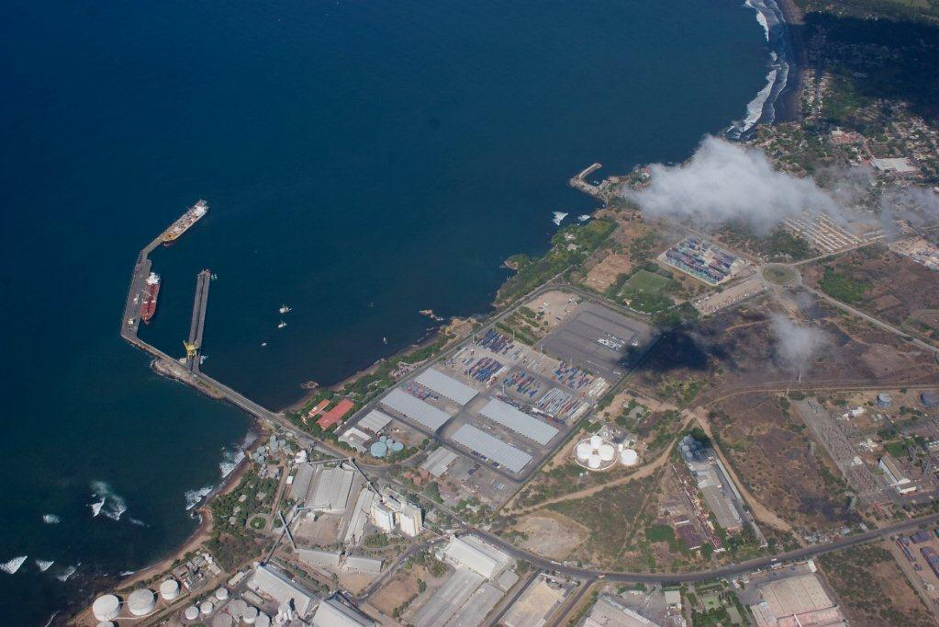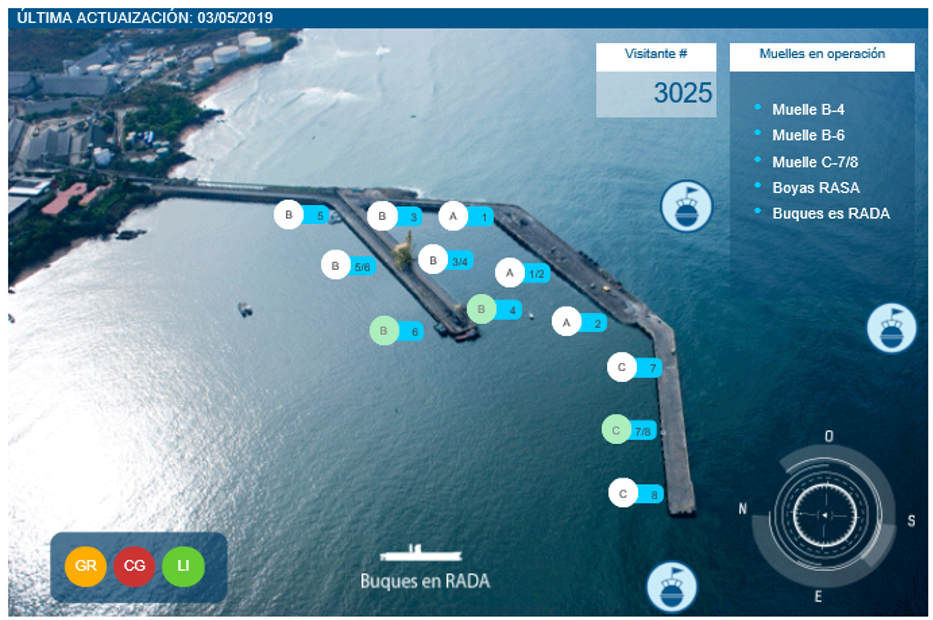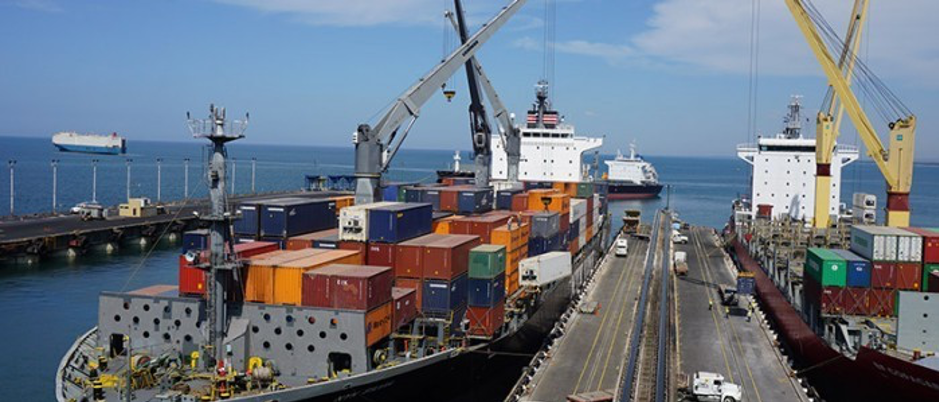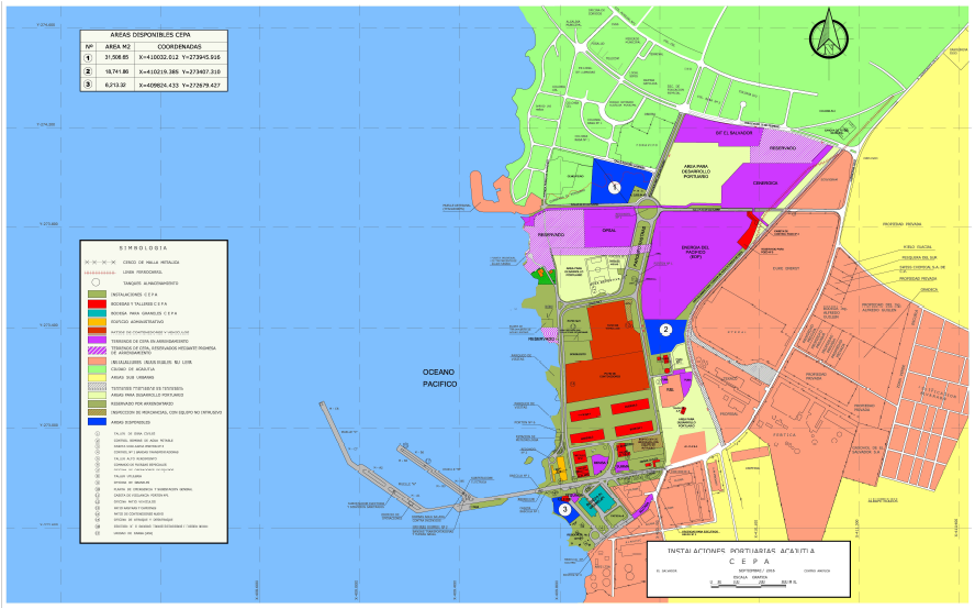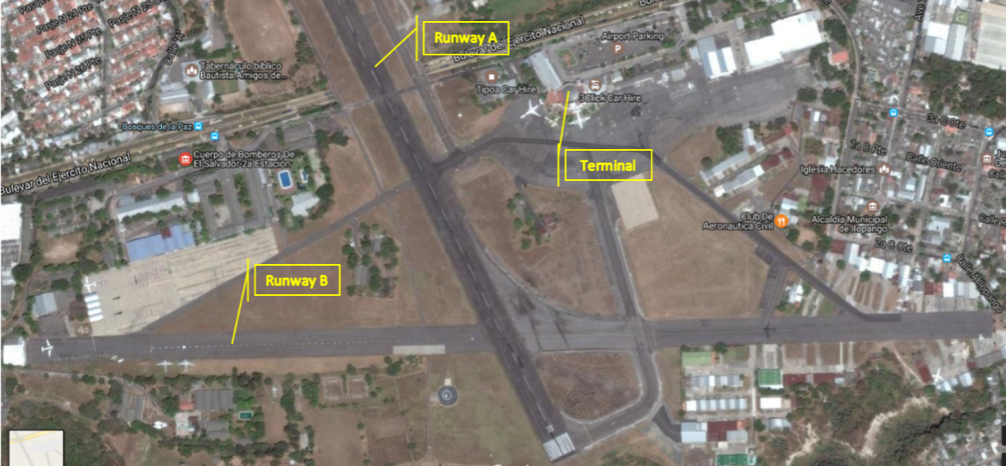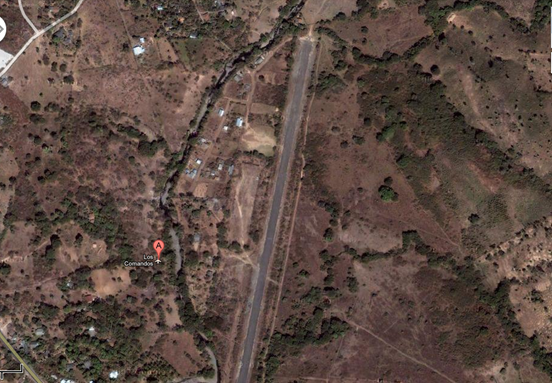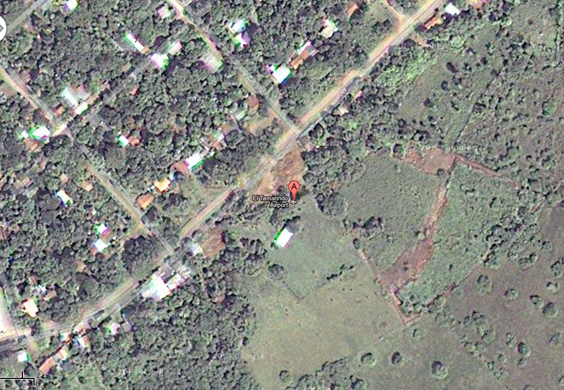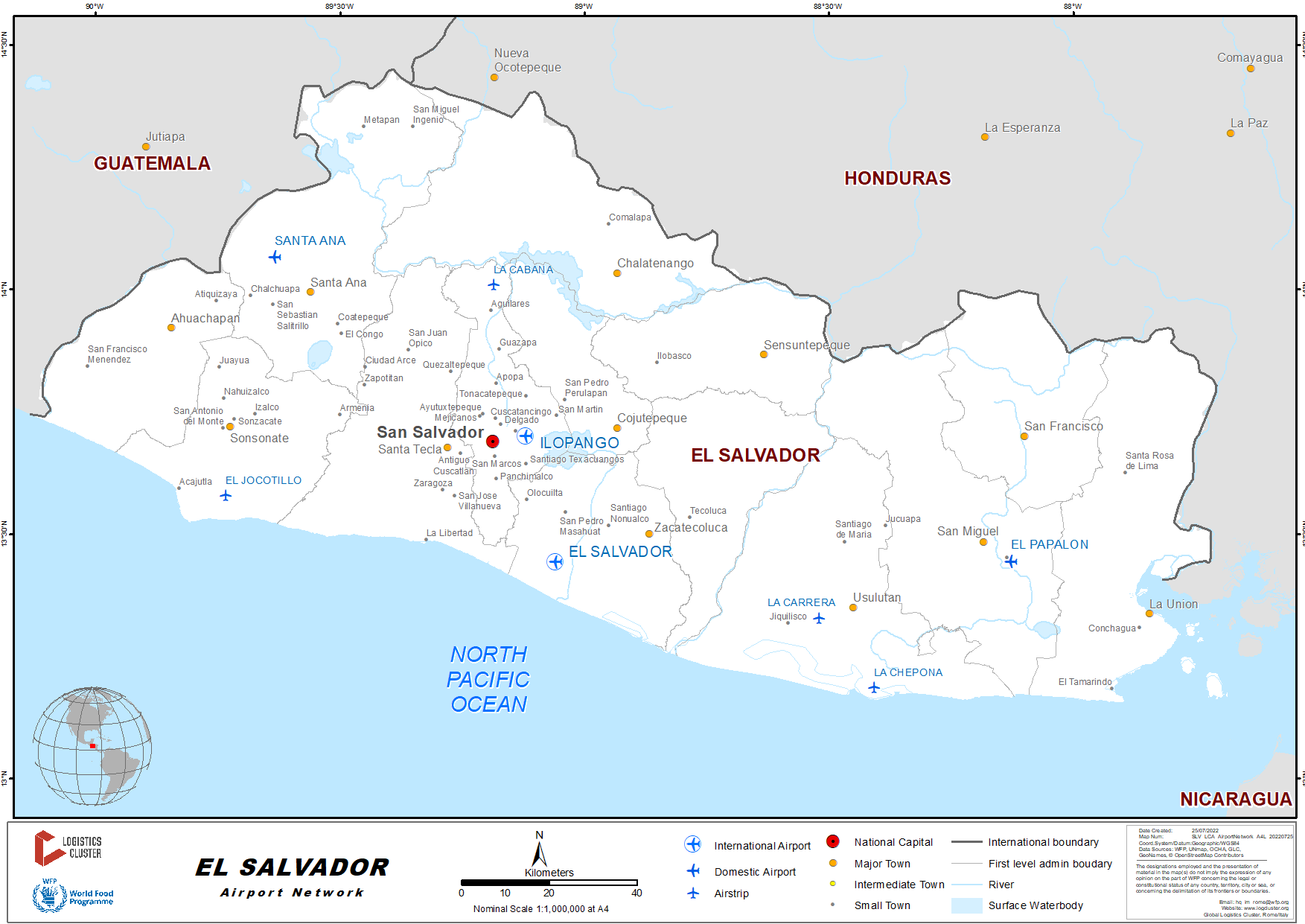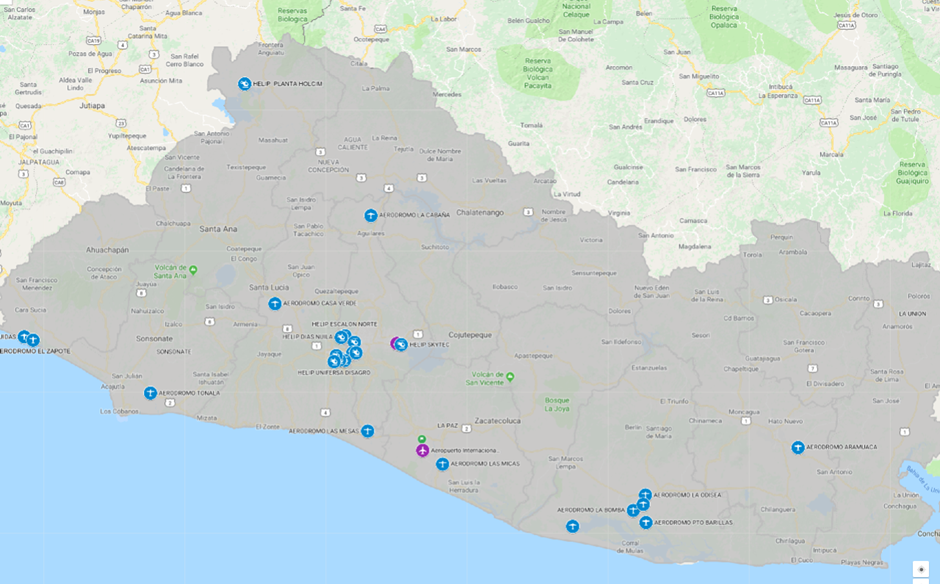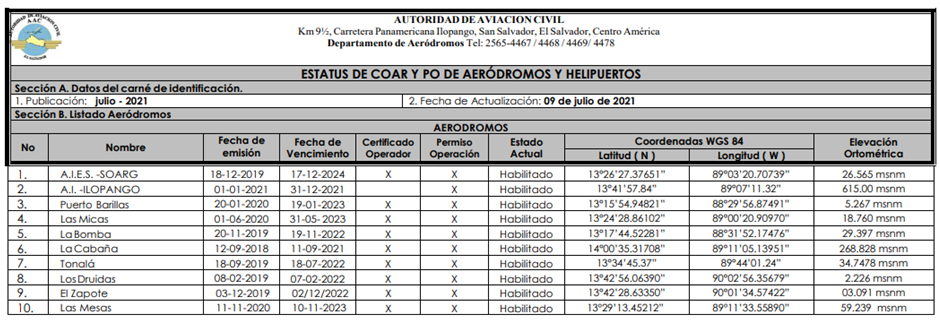El Salvador - 2 Logistics Infrastructure
According to the World Bank´s Logistics Performance Index El Salvador by 2023 had a score of 2.7. The country was placed as the second country with most difficulties to get into the global economy through commerce. This was due to the low logistics performance.
On the roads side, El Salvador in 2015 was the second country of the region for having the best roads. As of 2017 the total of paved roads was 3,748.89kms. By 2020, the country accounts 4,033.25km paved roads and 2,394.76km of non-paved roads. Due to the increase of traffic, new roads had to be open, i.e.: peripheral rings of Sonsonate and San Miguel.
As of 2019, El Salvador´s traffic has increased not only by the increase of vehicles, but also due to the public transportation disorder and its contamination due to the bad conditions of the buses. According to the vice-Ministry of Transportation the number of vehicles in 2019 was 1,237,000 with a monthly increase of 1.2%, which means 8,000 vehicles a month. This increase of vehicles has also congested the two main roads (littoral and Pan-American), which also is occupied by heavy trucks traveling along the central American countries.
El Salvador has two ports, Puerto de Acajutla and La Union. Acajutla port is the main port fully working receiving cargo ships. El Puerto de La Union was constructed by JICA (2005), however it operates an average of 8 ships a month. It is expected that this year it can operate in a project together with Port Calderas in Costa Rica. The project is to transport loaded trucks on a ferry between the two countries. It is worth to mention that at the same time the port of La Union was under construction, the Ministry of Education launched Logistics as a career to study so there would be prepared personnel to work on said port. Unfortunately, most of the graduates had to find jobs in other areas or are jobless.
At the moment El Salvador has the following ongoing projects:
-
A second USA Millennium project to improve the Litoral highway, and such the improvement of commerce on that area.
-
A ferry between La Union port in El Salvador and Calderas Port in Costa Rica for the use of a ferry to transport loaded trucks. This will enable the transit that is blocked at the border Nicaragua-Costa Rica.
-
MOARG International Airport is still expanding, operating at 100%. The improvements are more space in the waiting area, more shops and expanded space for more planes.
-
Construction of a peripheral ring road in San Miguel area for heavy transport go straight to El Amatillo border. This will help to decongest La Ruta Militar road, which crosses around San Miguel.
El Salvador - 2.1 Port Assessment
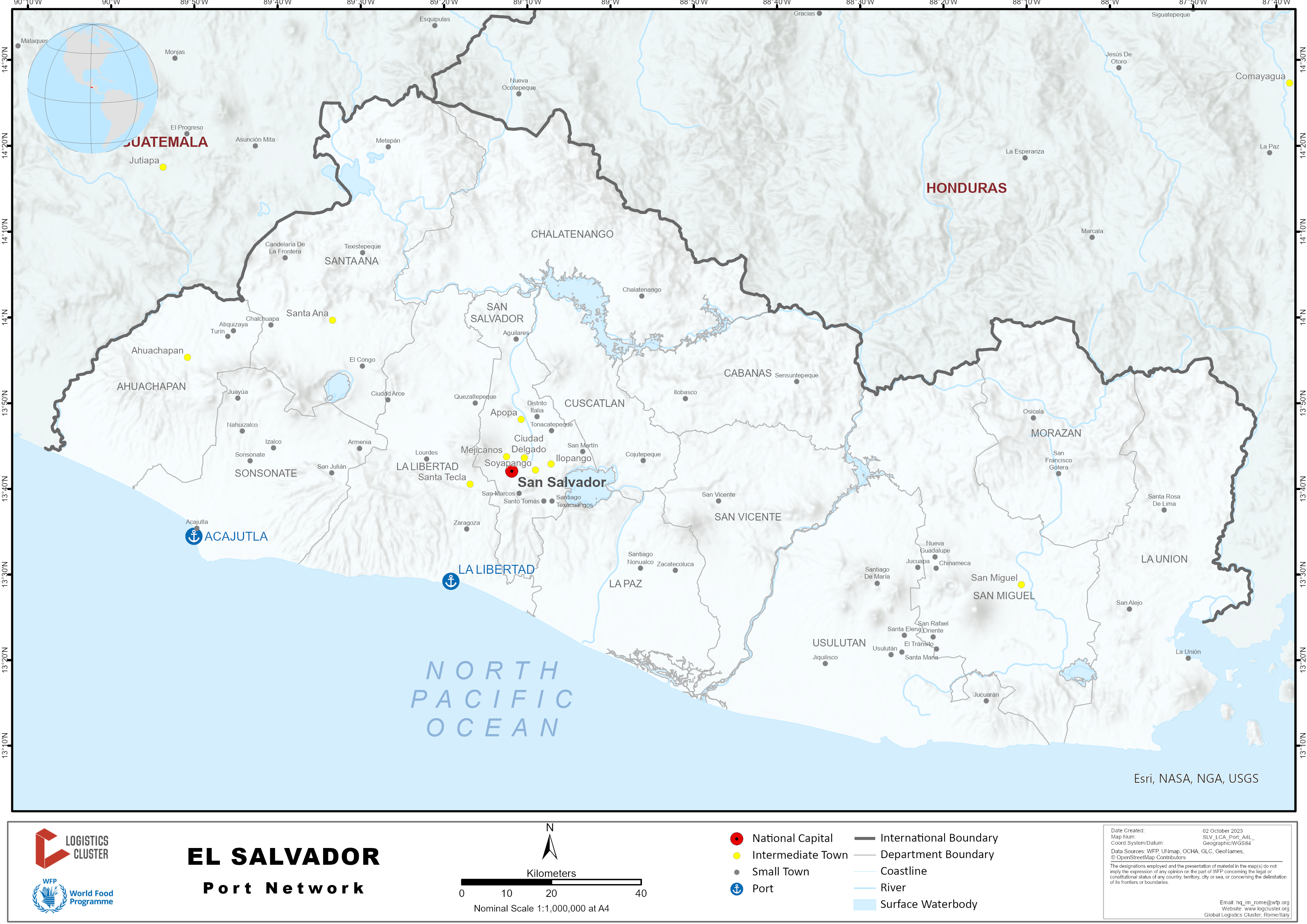
El Salvador has a versatile port infrastructure to meet the needs of maritime cargo effectively. The two main ports are Acajutla, located in the western region of the country and mainly specialized in handling bulk cargo, and La Union, located in the eastern region and designed especially for containerized cargo.
Port of Acajutla
The port of Acajutla has three modern terminals equipped for the arrival of all types of vessels, storage areas and specialized handling cargo equipment.
Port of La Unión
The Port of La Union is the largest port of El Salvador, and is projected as one of the most important and modern port infrastructures in Central America:
- Designed for large vessels such as the Post-Panamax type vessels, giving the port a competitive advantage in the region.
- Strategically located in the centre of the region, between Mexico and Panama.
- The newest maritime terminal with an expansion potential up to three times its current size.
- Contributes to the aim of the Government of El Salvador to turn the country into a distribution and logistics centre for Central America.
Foreign trade follows the following routes: towards Central America, by land and by sea, trade uses the ports located both on the Pacific and Atlantic Oceans. On the Pacific side, the ports of Acajutla are used for El Salvador and Port Quetzal for Guatemala; the Port of La Unión is to enter operations in the near term. The other route is through the Atlantic using Port Barrios in Guatemala, and to a lesser degree Port Cortés in Honduras.
El Salvador - 2.1.1 Port of Acajutla
Port Overview
Port of Acajutla is a modern industrial Pacific Ocean port located in the the municipal of Acajutla in the Department of Sonsonate, southwest of El Salvador, 85 km from the capital San Salvador. Acajutla has 3 piers with 8 total docs, with offshore, privately owned, moorings available. The port tends to service an average of 49 ships per month, carrying containers, general cargo ships and fuel which are attended to at an offshore terminal. Adverse weather conditions, strong ocean currents, affect the port from April to June sometimes requiring ships to leave their berths. This phenomenon mainly affects QUAY B.
|
PORT’s LOCATION & CONTACTS |
|
|
Country |
El Salvador |
|
Province and District |
Sonsonate Department |
|
Town or City (Closest) |
Acajutla |
|
Port Name |
Acajutla |
|
Latitude |
13º 43' 30'' N |
|
Longitude |
89º 50' 00´W |
|
Company / Port Authority |
Acajutla Port |
|
Management contact and Position |
Roberto Mendoza (Port Manager) |
|
Management contact and Position |
|
Key port information can also be found at: http://www.maritime-database.com/ports/topports.php
For more information on port contacts, please see the following link: 4.4 El Salvador Port and Waterways Company Contact List
Port Picture
Port Performance
The port is equipped with a system of conveyer belts for handling bulk grain shipments; there is only one berth that can service ships with the conveyer belt system at one time. Vessels should have no more than 10m of bathymetry if the conveyer is desired/foreseen. No priority is given to humanitarian cargo by the port and ships are attended to on a first-come first-serve basis. Storage capacity are as follows, Pier “A”, one covered warehouse 4,500 m², on land 4 covered facilities totaling 22,600 m². The conveyer belt system is run by two private companies, ALCASA and ALMAPAC. Bulk cargo is automatically transferred to their silos when the conveyer system is utilised. The silos at ALCASA have capacities of 143,000 mt, 47,000 mt in silos and 96,000 mt of storage is available in horizontal warehouses. ALCASA has the capacity to bag and dispatch 500 mt of product per day. ALMAPAC has a capacity of 120,000 mt in horizontal warehouses and 16,000 mt in silos. Bagging charge for ALMAPAC is US $2.60 / MT.
|
PERFORMANCE FOR 1ST QUARTER (2019) |
|
|
Vessels calls |
N/A |
|
Container traffic (TEUs) |
62,429 |
|
Total cargo handling (m. tons) |
512,560.88 |
|
Total annual capacity of the port |
The port has a capacity to service 8 vessels simultaneously and can store 3,400 containers. |
|
CAPACITY for 1ST QUARTER (2019): |
Bulk |
Container |
Conventional |
|
MT / 1 QTER |
TEU’s / 1QTER |
MT / 1 QTER |
|
|
Export activity of the Port |
262,007.02 |
31,731 |
130.32 |
|
Import activity of the port |
540,751.73 |
30,698 |
122,743.35 |
Discharge Rates
Link to relevant tariff/rates web page: http://www.puertoacajutla.gob.sv/regimen.php
Pilotage fees
Link to relevant website (e.g. for updates): http://www.puertoacajutla.gob.sv/regimen.php.sectionVI
Tug Services
Link to relevant website (e.g. for updates): http://www.puertoacajutla.gob.sv/regimen.php
Mooring Services
|
Mooring Service (Rate per operation) |
Charge (indicate currency) |
|
Mooring, un-mooring or other similar service |
Mooring service US $9/MT and the use of mooring US $105.00/calibrate/day or fraction |
Port and harbour dues
|
Vessel Description (rate = 100 GRT or part thereof |
Charge (indicate currency) |
|
All vessels other than those exempted |
US $0.31/GRT; Minimum to be charged US $195.50 |
Dockage, Buoy age and anchorage
|
Vessel Description (Rates = per meter/per hour) |
Charge (indicate currency) |
|
Vessels at piers, wharves or jetties |
For each meter length per day or fraction US $2.92; Minimum charged US $148.75 /day or fraction |
|
Vessels at buoys or Ro-Ro vessels berthed stern to quay |
N/A |
|
Vessels at anchorage; except at Port Convenience |
N/A |
Supply of Fresh water
|
Vessel Description (Rates = per ton) |
Charge (indicate currency) |
|
Via shore hydrants |
US $1.64/MT |
|
In stream (including towage of Barge) |
N/A |
Laying up of vessels
|
Vessel Description (Rates = per ton) |
Charge (indicate currency) |
|
Via shore hydrants |
N/A |
|
In stream (including towage of Barge) |
N/A |
Charges for general services - Hire of labour and equipment
|
Service (Per hour of part thereof) |
Charge |
|
Floating Crane, incl. of minimum crew and exclusive of towage |
N/A |
|
Mobile Crane more than 35 tons inclusive of driver Pier B |
US$/hour or fraction US $136.81 |
|
Load/unload unit Pier B |
US$/hour or fraction US $222.07 |
|
VIP launch inclusive of crew |
N/A |
|
Pilot boat inclusive of crew |
US $98.42/vessel |
|
Fire appliance inclusive of minimum crew |
N/A |
|
Tipper truck or flatbed lorry inclusive of driver |
Head terminal US $44.22/hour or fraction; Platform US$17.98/hour or fraction. |
|
Forklift or Tractor more than 5 tons inclusive of driver |
Up to 6,000 pounds US$/hour or fraction US $31.24. |
|
Forklift or Tractor less than 5 tons or equal of inclusive of driver |
More than 6000 pounds US $26.75. |
|
Van, Pick-up or Saloon Car inclusive of driver |
With capacity up to 30TM US$/hour or fraction US $4.62; with capacity more than 30TM US $9.98/hour or fraction |
|
Management or supervisory staff |
This service is included in the previous specified fee |
|
Skilled staff: e.g. Crane or Forklift Driver, Artisan, Firemen or Clerk |
Included in the equipment renting fee |
|
Semi-skilled staff: e.g. Laborer, Watchman |
Included in the equipment renting fee |
Berthing equipment specifications
|
PORT SPECIFICATIONS |
|||
|
TOTAL BERTHS: |
Quantity |
Length (m) |
Draft (m) |
|
Conventional Berths |
8 |
Pier A: Front Berthing 321 m
Pier B: Front Berthing North side: 348m, South side: 318m
Pier C: For Multipurpose, Front Berthing 280m |
Pier A-1: FWD 8.84 m AFT 10.30 m Pier A-2: FWD 10.30m AFT 11.00 m Pier B-3: FWD 8.23 m AFT 10.70m Pier B-4: FWD 10.70m AFT 11.5m Pier B-5: FWD 7.01m AFT 9.2m Pier B-6: FWD 9.2m AFT 9.5m Pier C-7: WFD 11.89m AFT 12.5m Pier C-8: WFD 10.5m AFT 14.39m The above measures are taken during low tide. |
|
Container Berths |
There is no specific container berth |
|
|
|
Bulk Oil Jetties |
N/A |
215 |
15 |
|
Cased Oil Jetties |
N/A |
n/a |
n/a |
|
Bulk Cement Berths |
N/A |
N/a |
n/a |
|
Lighter age & Dhow (other) Wharves |
3 |
n/a |
n/a |
|
Explosives Jetty |
N/A |
n/a |
n/a |
|
Berthing Tugs & Mooring Boats |
4 |
|
|
|
Pilot Boats |
2 |
|
|
|
Water Barges |
N/A |
|
|
|
Police Boats |
2 |
|
|
|
Anti-pollution Boats |
N/A |
|
|
|
Speed Boats |
N/A |
|
|
General services
|
Service (Per day of part thereof) |
Charge (indicate currency) |
|
Bagging plant operators, per unit of plant |
Not available in port but services can be provided by a private company |
|
Vacuvators, per unit of plant |
N/A |
|
Bunker Supplier |
N/A |
|
Bunkering Agent |
US $500 - per ship |
|
Barge operator, per barge |
N/A |
|
Fresh Water suppliers (road tankers) |
US $1.32/MT |
|
Ship Contractors |
N/A |
|
Ship Chandlers |
N/A |
|
Safety equipment supplier & service |
N/A |
|
Marine Contractors |
N/A |
|
Scrap Metal Dealers |
N/A |
|
Ship Watchmen Supplier |
N/A |
|
Marine Engineer |
N/A |
|
Marine Surveyor |
US $1,500 - per day |
|
Ship Surveyor |
US $1,500 - per day |
|
Cargo Surveyor |
US $1,500 - per day |
|
Sludge Collector |
N/A |
|
Small Boat Operator |
N/A |
Port cargo handling equipment
|
PORT CARGO EQUIPMENT (OPERATIONAL) |
||
|
Appliance |
Quantity |
Capacity |
|
Traveling cranes |
No traveling cranes |
|
|
Portal Electric cranes |
No portal electric cranes |
|
|
Electric overhead electric cranes |
No electric overhead cranes |
|
|
Gantry container cranes |
1 |
430 MT conveyor belt system for bulk cargo, Pneumatic unloader for bulk cargo |
|
Mobile Cranes |
3 |
2 traveling cranes with a capacity of 25 MT and 35 MT |
|
Freight Elevator |
60 |
6,000 pound to 5 MT capacity |
|
Clamp Freight Elevator |
3 |
8,000 pound capacity |
|
Forklift Trucks |
5 |
8,000 pound capacity |
|
Forklift for Taylor containers |
1 |
|
|
Tractors trucks and trailers |
14 |
|
|
Tractor |
16 |
10,000 pound capacity |
|
Fire engines |
1 only |
|
|
Clamshell buckets |
16 |
|
|
Metal Hopper |
7 |
|
|
Container spreader |
6 |
|
|
Front loading Units |
10 |
|
|
Crawler Tractor |
17 |
|
|
Straddle Carriers |
5 |
|
|
Light Truck |
43 |
30 MT to 50 MT |
|
Tugs |
6 |
1: 900HP, 1: 600HP, 2: 38.2 MT bp and 2: 250HP to carry pilot between wharf and vessel. Tugs are also used for mooring and unmooring vessels at buoys. |
|
Band System connected to main plants, reception and export |
1 |
500 MT/hr capacity |
Container Facilities
With an area of 48,500m2 and with a capacity of 2,778 TEUS, stowed at three levels, and being able to attend simultaneously 160 cold containers.
|
CONTAINER FACILITIES |
|
|
|
20 ft (TEUs) |
40 ft (TEUs) |
|
|
Container facilities |
Yes |
Yes |
|
Daily off-take capacity (No of containers/hour) |
25-30 |
There is no distinction |
|
Container Freight Stations (CFS) |
Yes |
Yes |
|
Number of CFS |
1 |
1 |
|
Capacity of CFS (No of containers/hour) |
25 to 30 |
There is no distinction |
|
Refrigerated Container Stations |
Yes |
Yes |
|
Number of Stations (connection points) |
101 |
There is no distinction |
|
Capacity area |
48,000 m2 container yard with 2,514 TEU of storage capacity (three high) and 120 reefer plugs |
|
General Cargo handling berths
|
General Cargo – Imports |
Berths |
|
Imports – Bagged Cargo |
US$6.64/MT |
|
Exports – Bagged Cargo |
US$6.64/MT |
|
Imports – Steel Goods |
US$3.62/MT |
|
Imports & Exports – Ro-Ro |
US$11.98/MT |
|
Imports – Vehicles |
US$11.98/MT |
|
Others Imports |
Sugar in bags US$5.24 , Cement in bags US$9.24 |
Terminal Information
Oil Handling Terminal
The port of Acajutla is a multipurpose port, consisting of three quays called A, B and C, designed to accommodate vessels with average lengths of 150 meters. The loading or unloading of bulk liquid is carried out through pipes installed by different companies on the docks A and C. Likewise there are three private terminals handling liquid bulk outside the docks. The first terminal is owned by the company Refinery Port of Acajutla (RASA), the second one is owned by the Company CENERGICA. A third one is owned by ALBA Petroleum. CEPA has no storage tanks for liquid bulk, the goods move from Muller tanks owned by private enterprises or vice versa. When the ships arrive in port and conduct their operations on the docks, they are placed in positions of berthing previously allocated by CEPA, right on the sites where importing or exporting companies have installed their inlet pipes to conduct discharge from the docks to storage tanks or vice versa.
The main imported products are mobilised: Ethanol or alcohol, petrol and diesel; the main export products are: Ethanol Alcohol and molasses or cane.
Multipurpose terminal
Port Acajutla is a multipurpose port and there is not a specific multipurpose terminal.
Grain / Bulk handling
The discharge of solid bulk can be done in any of the quays of the Acajutla Port, in two ways:
- Using Conventional Methods: The download is done using cranes of the ship. The product is moved from the holds of the ship to dump located on the docks, and after it is placed in transport units to be moved towards private storage companies outside the port or into cellars strains known as BIN (whose capacity Storage is 18,000 MT).
- Using System High Performance: The download is done using a crane, which is connected to a conveyor system to move the product from the holds of the ship directly in the company’s storage, or by downloading from the cellars of the ship by conveyor belt and deposited in the transport units to be further moved to companies’ private storage outside the port or into cellars known as BIN.
The main bulk of solid imported are: corn, soy flour, wheat, rice, coal, urea fertilizer formulas, ammonium sulphate. The operations of all ships arriving at Port Companies are performed by six private contractors, who assign strains ships under a pre-established procedure.
A) Main Silo terminal: Warehouse for storing bulk solids for export fitted with 2,400 m2 with a capacity of 12,000 MT, it is equipped with a conveyor system for handling cargo. The warehouse for the storage of solid bulk import has an area of 2,500 m2 and a capacity of 18,000 MT, spread over 6 bins of 1,000 MT and another 6 of 2,000 MT each. The warehouse is equipped with a system of belts.
B) Main storage terminal: It has a roofed area of 26,300 m2 to store up to 113,900 MT of various products.
C) 48,000 m2 container yard with 2,514 TEU of storage capacity (three high) and 120 reefer plugs.
D) 35,000 m2 storage yard for up to 2,000 vehicles.
ALMAPAC (Almacenadora del Pacifico): Company specialised in the handling of food and industrial products, solid or liquid. It is located inside the port terminal.
Solid products:
- 6 warehouse 210,000 MT
- 4 metallic silos 10,000 MT
- 6 concrete silos 6,000 MT
Liquid products:
- 3 tanks for grease 2,200 MT
- 6 tanks for molasses 52,000 MT
General:
- 1 Warehouse general use: 3,000 MT
Container yard:
- 1 Yard for repair/storage of empty containers 4,000 TEU
Bagging: US$ 2.60 / MT
Address:
Final zona industrial del Puerto de Acajutla, Departamento de Sonsonate.
Tel.: (503) 2445-8900
Fax: (503) 2445-8907
ALCASA (Almacenadora Centroamericana S.A. de C.V): This company provides a specializsd service in the handling and warehousing of cereals and grains in transit, as well as general products. They provide services of reception, bagging, warehousing and delivery. ALCASA has the capacity to bag and dispatch 500 MT of product per day.
- 7 Automatic and non-automatic warehouses with a total capacity of 96,000 MT
- 3 Concrete Silos with a capacity of 47,100 MT.
- Conveyor belts connected to the port with a capacity of 500 MT/Hour.
- 6 Hopper
- 3 Electronic platform scales
- 1 Weighbridge
- Open area of 30,000 m2.
Address:
Planta ALCASA, Zona industrial Puerto de Acajutla, Sonsonate
Tel. 2429-7700
Fax: 2452-3131
Stevedoring
CEPA outsourced the handling/stevedoring services to 3 different companies, counting on about 635 workers. Furthermore, CEPA has contracted 4 private companies for the management of about 195 staff for cleaning and maintenance.
Conventional cargo
|
Other Services |
Charge (indicate currency) |
|
Mail per bag, or ships stores per package |
N/A |
|
Returning empty bags |
N/A |
|
Repairs in the breakage room per package |
N/A |
|
Crated animals, per cubic meter of crate |
Animals in foot US$ 3.53/unit |
|
Animals handled by sling |
Animals in foot US$ 3.53/unit |
|
Animals walked on/off board |
Animals in foot US$ 3.53/unit |
Hatch and other than standard freight
|
Stevedoring – Large Packaged Articles |
Charge (indicate currency) |
|
From 14 DWT to 40 DWT |
US$ 2.95/MT |
|
Over 40 DWT |
US$ 2.95/MT |
Containerized cargo
|
Containerized Cargo Handling Charges
|
|
|
|
(TEUs) |
(FEUs) |
|
|
Discharge, loading, shifting within the hold or shifting on deck without landing |
US$ 13.97/container |
US$13.97/container 20´ |
|
Containers handled via a conventional ship |
US$36.93/container |
US$ 36.93/container |
|
Containers handled on a Ro-Ro basis |
N/A |
N/A |
|
Empty containers |
US$19.32/container |
US$19.34/container 20´ |
|
Transshipment containers, overland containers, containers shipped & re-landed or landed & re-shipped or shifted from hold to hold |
US$26.44/MT |
US$26.44/MT |
|
Stripping or Stuffing of Containers
|
|
|
|
(TEUs) |
(FEUs) |
|
|
Stripping or Stuffing |
US$3.06/MT |
US$3.06/MT |
|
Stripping and re-stuffing transshipment cargo |
US$3.06/MT |
US$3.06/MT |
Other container handling services
|
Other Container Handling Charges
|
|
|
|
(TEUs) |
(FEUs) |
|
|
Cover or pontoons which can be lifted using a standard ISO twist lock spreader |
N/A |
N/A |
|
Other cover or pontoon |
N/A |
N/A |
|
Transfers to/from the Container Terminal |
Assignable to the consignee or shipper US$ 4.73/MT; assignable to the shipping firm US$ 10.87/MT |
Assignable to the consignee or shipper US$ 4.73/MT; assignable to the shipping firm US$ 10.87/MT |
|
Other transfers within the terminal are not charged |
N/A |
N/A |
|
Handling of empty containers at ICD's |
US $13.97/Cont |
US $13.97/Cont |
|
Reefer containers plugged onto reefer points |
US $20.10 |
US $40.00 |
|
Storage of import empty containers from two days after arrival or empty export containers from date of loading |
Daily cost US $1.20
|
Daily cost US $2.40 |
|
Storage of full import containers from date of arrival |
Daily cost US $0.07 day 11th to 14th. After $ 0.23 P/MT Daily cost (refrigerated)US$20.10 |
Daily cost US $2.40 Daily cost (refrigerated) US $30 |
Shore Handling - Conventional Cargo
|
Conventional Cargo (Rate per ton or part thereof) |
Charge (indicate currency) |
|
Direct discharge/loading of imports/exports |
US $6.64/MT |
|
Crude Petroleum Oil Imports |
US $1.39 /MT |
|
Other Liquid Bulk Imports |
US $2.10 /MT/ by pipes, US $2.87/MT/by truck |
|
Other Imports |
N/A |
|
Liquid Bulk Exports/Bunkering |
N/A |
|
Other Exports |
N/A |
|
Conventional Cargo (Rate per ton or part thereof) |
Charge (indicate currency) |
|
Import Cargo Handled at ICD's |
US $13.97/cont |
|
Export Cargo Handled at ICD's |
US $13.97/cont. |
|
Shut-out Cargo removed from the Port |
N/A |
|
Fumigation of Cargo |
US $ 68.57/container * |
|
Palletizing/pre-slinging in the Port on request |
N/A |
|
Dangerous Cargo |
N/A |
|
Conventional Cargo (Rate per ton or part thereof) |
Charge (indicate currency) |
|
From 14 DWT to 40 DWT |
US $11.91/MT |
|
Over 40 DWT |
US $11.91/MT |
|
Hire of a gang |
N/A |
Shore handling - Containerized cargo
|
Shore Handling charges
|
|
|
|
(TEUs) |
(FEUs) |
|
|
Import Containers |
US $33.66/container |
US $33.66/container |
|
Export Containers |
US $33.66/container |
US $33.66/container |
|
Stripping & re-stuffing for customs verification |
US $13.97/container |
US $13.97/container |
|
Stripping & re-stuffing of un-nominated or shut-out export cargo |
US $13.97/container |
US $13.97/container |
|
Stripping or re-stuffing of containers taken to Customs Warehouse |
N/A |
N/A |
|
Shore Handling charges |
Charge (indicate currency) |
|
Ten day removal charges, or transfer within the Port, or transfer to Customs |
US $13.97 |
|
Import Containers handled at the Inland Container Depots |
N/A |
|
Exports Containers handled at the Inland Container Depots |
N/A |
|
Domestic FCL Container Charges
|
|
|
|
(TEUs) |
(FEUs) |
|
|
The first 5 days |
US $0.07 p/TM |
US $0.07 p/TM |
|
From day 6th to 15th |
US $0.23 p/TM |
US $0.23 P/TM |
|
16th day thereafter |
US $0.47 P/TM |
US $0.47 P/TM |
Clearing Agents
|
Company Name and address |
Contact Names / Email |
Tel / Fax |
Website |
|
Blue Logistics, Edif. 15 Norte, Parque de servicios Export Salva Km. 24 Carr. A Santa Ana, La Libertad |
Name: Boris Leon Email:info@bluelogistics.com.sv |
Tel.(503) 2525 – 6800 / 2338 - 4425
|
|
Company Name and address |
Contact Names / Email |
Tel / Fax |
Website |
|
America Logistics Group /A.Bernal y Calle Sisimiles#592,Col Miramonte |
Tel:(503)2555 -2700 |
Port Security
|
SECURITY |
|
|
ISPS Compliant |
Yes |
|
ISPS Level (current) |
2 |
1=Normal; 2=Heightened; 3=Exceptional
Storage facilities
|
Port Storage |
||
|
Total floor space - 119,000 m2 |
Quantity |
Floor area |
|
Main Quay Transit Sheds |
1 |
11,585 m2 |
|
Back of Port Transit Sheds |
N/A |
N/A |
|
Lighterage Area Transit Sheds |
N/A |
N/A |
|
Customs Warehouses |
1 |
48,000 m2 |
El Salvador - 2.1.2 Port of La Unión
Port Overview
The New Port of La Union is one of El Salvador’s main infrastructure with total investment US$200 million. It was inaugurated by GoES in June 2010. The project was financed by Japanese Bank for International Cooperation (JBIC) and a government agency, Comisión Ejecutiva Portuaria Autonoma (CEPA).
Among the facilities that the Port of La Union offers to potential licensees include: high level of port infrastructure, with more than 50 ha of work (1 Stage), with deep-water docks where boats can dock Post Panama type that can mobilise up to 6500 TEUs; space for future development of facilities, road connectivity and the possibility of developing a rail connectivity.
Port website: http://www.cepa.gob.sv/tag/puerto-la-union
Key port information may also be found at: http://www.maritime-database.com
|
Port Location and Contact |
|
|
Country |
El Salvador |
|
Province or District |
La Union |
|
Nearest Town or City with Distance from Port |
La Union DISTANCE (2km) |
|
Port's Complete Name |
Puerto de la Unión Centroamericana |
|
Latitude |
13° 20’ 9’’ north latitude |
|
Longitude |
89° 03’ 20” west longitude |
|
Managing Company or Port Authority |
CEPA El Salvador – Comisión Ejecutiva Portuaria Autónoma |
|
Management Contact Person |
Federico Anliker |
|
Nearest Airport and Airlines with Frequent International Arrivals/Departures |
Airport of Ilopango, 177.6 km |
Port Picture
Port Performance
Since its inauguration in 2010, the port has been barely used (95 vessels between 2014 and 2017). The government of Japan, through JICA, in 2019, started an assessment to the port in order to support the improvement of the basis for economic and social development through the development of economic infrastructure. In addition, it will promote technical assistance that contributes to the activation of the Port, built under the Reimbursable Financial Cooperation scheme. With this strategy is its hoped to define its role against Port of Acajutla and its complementarity to Puerto Cortes in Honduras and Port Santo Tomas de Castilla in Guatemala.
Statistics for 2019 show a total reception of 21 vessels (18,041.19MT: 23,242 TEU).
At the moment the type of ships that can enter to the port are those type of Panamax that mobilise 4,66 TEU or Post Panamax mobilising 6,500 TEU.
Port size: small
Access Chanel: Dredging 13 million m3 approx.
Interior Canal:
- Length: 5.0 km.
- Deep: 14.00 MT.
- Width: 140 MT.
- Signal Range: 3 Mn.
Exterior Canal:
- Length 17.00 Km.
- Deep: 14.50 MT.
- Width: 140 MT.
- Signal Range: 4 Mn
Navigation Aids.
- 16 Marker buoys.
- GPS Radios
- 1 Navigation Lighthouse
- Visibility: 22 Nautical Miles
|
Seasonal Constraints |
||
|
|
Occurs |
Time Frame |
|
Rainy Season |
Yes |
From May to November |
|
Major Import Campaigns |
No |
|
|
Handling Figures for 2019 |
|
|
Vessel Calls |
N/A |
|
Container Traffic (TEUs) |
873 (2011) |
|
Handling Figures Bulk and Break Bulk for 2019 |
|
|
Bulk (MT) |
|
|
Break bulk (MT) |
17,452.06 |
Discharge Rates and Terminal Handling Charges
For information on port rates and charges, please see the following link: https://www.transparencia.gob.sv/institutions/cepa/documents/servicios
Berthing Specifications
|
Type of Berth |
Quantity |
Length (m) |
Maximum Draft (m) |
Comments |
|
Conventional Berth |
1 |
220 |
10 |
|
|
Container Berth |
1 |
340 |
15 |
Total area: 174,722 m2, Capacity: 350,000 TEUs |
|
Silo Berth |
No info |
No info |
No info |
|
|
Berthing Tugs |
None |
|
|
|
|
Water Barges |
By pipeline |
|
|
|
General Cargo Handling Berths
|
Cargo Type |
Berth Identification |
|
Imports - Bagged Cargo |
No info |
|
Exports - Bagged Cargo |
No info |
|
Imports and Exports - RoRo |
No info |
|
Other Imports (2019) |
18,041.19 |
Port Handling Equipment
The port equipment is handled by governmental personnel. The equipment is not used 100% since very few vessels arrive there.
|
Equipment |
Available |
Total Quantity and Capacity Available |
Comments on Current Condition and Actual Usage |
|
Dockside Crane |
|
No information |
No information |
|
Container Gantries |
Yes |
4 |
|
|
Mobile Cranes |
|
No information |
No information |
|
Reachstacker |
|
No information |
No information |
|
RoRo Tugmaster (with Trailer) |
Yes |
5 tugmasters, 5 trailers |
No information |
|
Grain Elevator with Bagging Machines |
|
No information |
No information |
|
Transtainer |
Yes |
4 |
No information |
|
Forklifts |
Yes |
4 / 6,000 lb |
|
Container Facilities
Facilities for containers are mostly empty due that not many vessels arrive to the port.
|
Facilities |
20 ft |
40 ft |
|
Container Facilities Available |
|
560 x 560 mts |
|
Container Freight Station (CFS) |
No information |
|
|
Refrigerated Container Stations |
No information |
|
|
Other Capacity Details |
No information |
|
|
Daily Take Off Capacity |
No information |
|
|
Number of Reefer Stations |
No information |
|
|
Emergency Take-off Capacity |
No information |
|
|
Off take Capacity of Gang Shift |
No information |
|
Customs Guidance
Although there is little movement at the port, Customs office is active. There is no information regarding on how long it takes to get shipment out of the port.
There is also an office in La Union: 3ra calle Pte. Sector La esperanza, Colonia Belén, No. 22, La Union. Phone No.: +503 2604-4106 / 2637-0173.
Terminal Information
MULTIPURPOSE TERMINAL
Multipurpose terminal is available with the following information:
Berth length: 220 m
Depth: -10 m
Total area: 115,981 m2
There is also a Ro Ro and passenger terminal with the following information:
Berth length: 240 m
Depth: -9.5 m
Total area: 34,871 m2
GRAIN AND BULK HANDLING
There is no information with this regard.
MAIN STORAGE TERMINAL
There is a warehouse for general cargo, which is located at the multipurpose terminal and its working hours are as follow:
- Monday: 08:00 – 17:00hrs
- Tuesday to Thursday: 07:00 – 17:00hrs
- Friday: 07:00 – 15:45hrs
So far what has been stored is: iron and steel (metal, ingots, rolls, coils, sheets, messes, loose parts, others) and fractional General cargo. Whichever shipping company or customer must present the Tarja note and the partial bill of departure and a payment of USD 0.39 par metric ton.
Port Security
Port security is maintained 24 hours a day.
|
Security |
|
|
ISPS Compliant |
Yes |
|
Current ISPS Level (Level 1 = Normal, Level 2 = Heightened, Level 3 = Exceptional) |
1 |
|
Police Boats |
No info |
|
Fire Engines |
Yes |
El Salvador - 2.2 Aviation
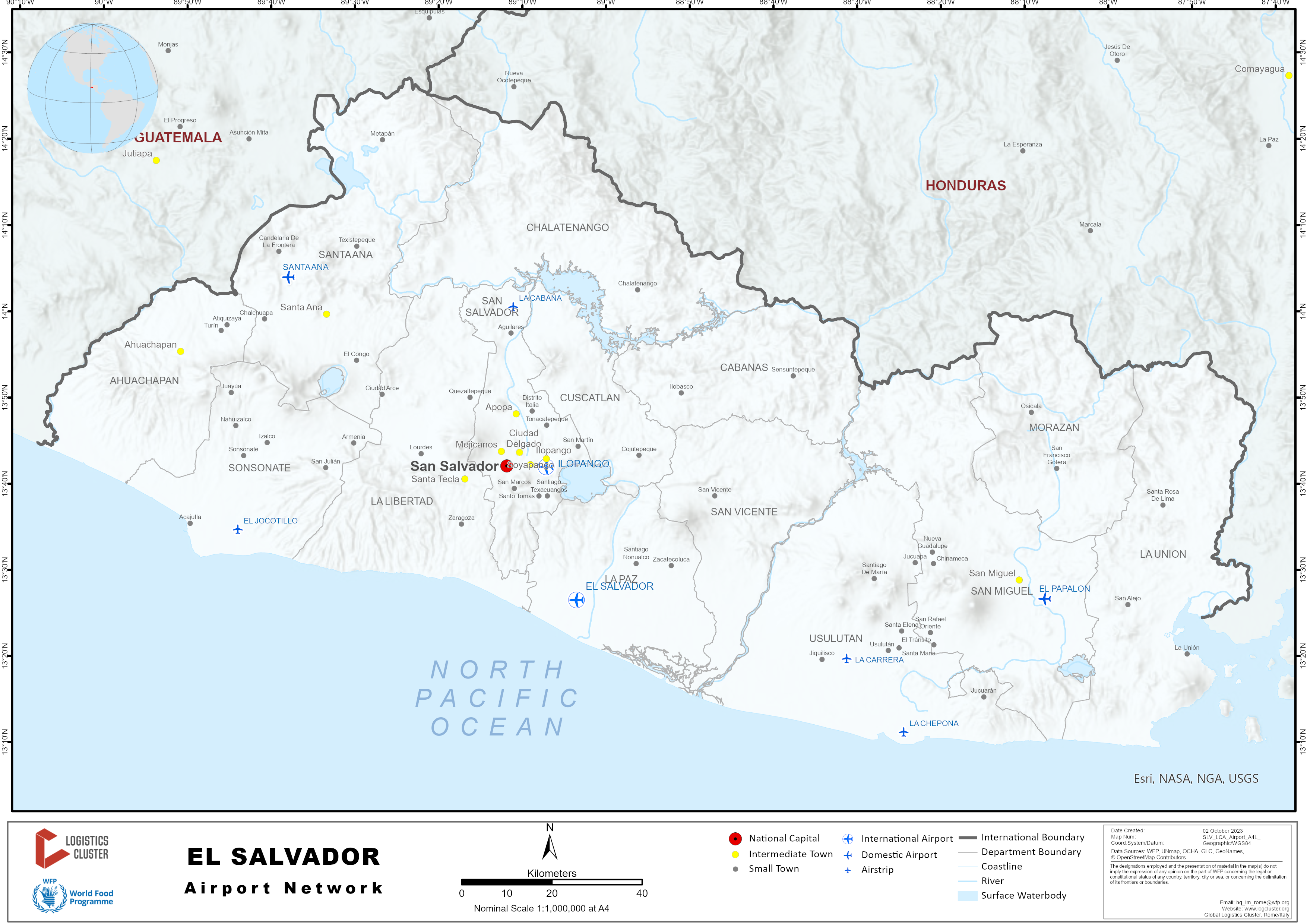

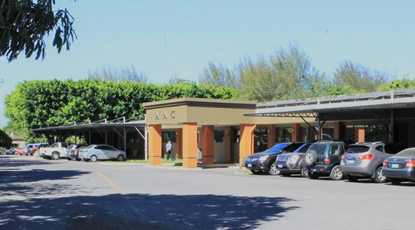

Key airport information may also be found at: https://www.cepa.gob.sv/
Key airport information may also be found at: World Airport Database
Overview
When the Civil Aeronautics Act was issued in 1955, it also included the creation of the Department of Civil Aviation, which in 1962 became the General Directorate of Civil Aviation (DGCA). DGCA was given the responsibility to develop the modernization project of Ilopango International Airport, which was concluded later in 1965. In December 1979 it was agreed to suspend the international traffic in Ilopango Airport as of January 1980, moving the traffic to Comalapa Airport (managed by CEPA), which became the main airport for El Salvador. Ilopango remained active only for military use and for a small proportion for civil aviation. In October 1987 the Ilopango airport re-opened for international traffic in a limited way, for private aviation operations, air taxis, air ambulances, flights on official duty, civilian and military assistance. In 1994 with the establishment of the Department of Transportation, the DGCA ceased to belong to the Ministry of Economy and became part of this Department under the name of Directorate General of Air Transport (DGTA). In October 2001 the Legislative Assembly of El Salvador adopted the new reforms of the DGTA including the autonomy of the institution to become the Civil Aviation Authority. Beginning in 2005 the institution has been restructured to improve its technical staff and expanding the service coverage. By 22 March 2017, the Civil Aviation approved an Advisory Circular “Airports Emergency Plan” (CA No. 139-365-05), regarding a plan to be followed in case of emergency inside/outside the airports and airplanes. In follow-up to know the achievement of this plan.
|
Authority and address |
Contact Names / Email |
Tel / Fax |
Website |
|---|---|---|---|
|
Civil Aviation/Boulevard del Ejército Km. 9 1/2, contiguo Zona Franca San Bartolo. Ilopango |
Name: Ing. Jorge Alberto Puquirre Title: Director Ejecutivo Email: jpuquirre@aac.gob.sv |
Tel. (503) 2565-4406 Fax (503) 2565-4408 |
|
|
Location: 13°26′33. 85’N Latitude 89°03′20″ W Longitude |
|||
For more information on government agency and airport company contact information, please see the following links: 4.1 Government Contact List and 4.5 Airport Companies Contact List.
Procedures for foreign registered aircrafts
These are the steps to be followed to obtain the landing authorization in Comalapa airport:
-
Under normal conditions, a written request (to land in the national territory) needs to be submitted to the Ministry of Foreign Relationship (Ministerio de Relaciones Exteriores de El Salvador)
-
This Ministry will forward the request to the Ministry of National Defense. It is necessary to include in the request the type of aircraft, date of arrival and departure, objective of the operation, etc.
-
As required by the Civil Aviation Authority, for each aircraft that lands in El Salvador, the flight plan needs to be communicated to the Airport Authority.
El Salvador - 2.2.1 Monseñor Oscar Arnulfo Romero International Airport
Airport Overview
| Airport Location and Details | |
|---|---|
|
Country |
El Salvador |
|
Province / District |
San Luis Talpa / La Paz |
|
Town or City (closest) |
San Salvador |
|
Airport's Complete Name |
Monseñor Oscar Arnulfo Romero y Galdamez International Airport |
| Latitude |
13.445098 |
| Longitude |
-89.057138 |
| Elevation | 30.78 meters (101ft) |
|
IATA Code |
SAL |
|
ICAO Code |
MSLP |
| Managing Company or Airport Authority | CEPA |
Main Airport
|
Authority and address |
Contact Names / Email |
Tel / Fax |
Website |
|---|---|---|---|
|
Civil Aviation /Boulevard del Ejército Km. 9 1/2, contiguo Zona Franca San Bartolo. Ilopango |
Name: Ing. Jorge Alberto Puquirre Title: Director Ejecutivo Email: jpuquirre@aac.gob.sv |
Tel. (503) 2565-4400 Fax (503) 2565-4408 |
|
|
https://www.aeropuertos.net/aeropuerto-internacional-de-el-salvador/ http://www.cepa.gob.sv/tag/aeropuerto-internacional-de-el-salvador |
|||
|
Airport Name and Management |
Contact Names / Email |
Tel / Fax |
Website |
|---|---|---|---|
|
El Salvador International Airport-Oscar Arnulfo Romero y Galdamez |
Name: Ing. Ricardo Duarte Title: Gerente Email: ricardo.duarte@cepa.gob.sv |
Tel. (503) 2375-2520 2375-2200
|
|
General Overview
El Salvador International Airport (AIES) has a main runway (07-25) of 3,200 meters long, 60 meters wide. Parallel to the main runway there is the taxiway "Alfa", which connects the track through six outings. For use of small aircraft, it was built also a secondary runway (18-36), with a length of 800 meters, which is currently used as parking "LP" for aircraft. The platform of the Passenger Terminal Building (ETP) has seventeen positions for aircraft parking; fourteen of them have their respective boarding bridges, connecting the aircraft directly to their waiting rooms. The three remaining positions are "remote", meaning that passengers who disembark in any of them are transferred to the terminal with airbuses. The ETP has built a total area of 34,380 square meters, which is home to waiting rooms and corridors, areas of Immigration and Customs and diversity of stores. Based on passenger traffic, this is the third busiest airport in Central America. In 2010, fewer than two million passengers passed through AIES.
It is expected that before the end of the first half of 2021 the expansion of the airport will be inaugurated, which will include 5 new waiting rooms for passengers.
It is important to mention that the WFP has an agreement with the 2nd. air brigade of the Salvadoran Air Force, next to the airport, where we have a military ramp for PMA air activities, as a second option for operations.
Performance
|
Performance |
Year(s) and figures |
|---|---|
|
Total aircraft movements |
45,854 Comercial aircrafts (2017) Info: Anexo XXVI Aeronaves_Comerciales 2017.pdf |
|
Total passengers |
2,517,000 Mobilized passengers (Entry, Exit, Transit, On board, 2021) Info: Anuario estádistico AIES 2021 |
|
Current monthly use by Humanitarian flights (UNHAS) |
N/A |
Cargo capacity
Cargo movement in 2021: 35,076,643 Kg
Info.: Anuario estadístico AIES 2021
|
Capacity Cargo |
Year(s) and figures |
|---|---|
|
Total aircraft movements |
33,760 operations (2021) |
|
Total capacity of the airport (kg) |
N/A |
|
Current activity of the airport (kg) |
2021: Import activity = 16,041,656; Export activity = 19,034,987 |
|
Current monthly use by Humanitarian flights (UNHAS…) |
N/A |
Airfield details
Airfield details |
|||
|---|---|---|---|
|
Customs |
Yes |
JET A-1 fuel |
Yes |
|
Immigration |
Yes |
AVGAS 100 |
Yes |
|
Terminal building |
Yes |
Single point refueling |
Yes |
|
Passenger terminal |
Yes |
Starter units (press air) |
Yes |
|
Cargo terminal |
Yes |
Ground power (mobile) |
Yes |
|
Pax transport to airfield |
Yes |
Crash crew |
Yes |
|
Control tower |
Yes |
Aircraft support services |
Yes |
|
Weather facilities |
Yes |
Latrine servicing |
Yes |
|
Catering services |
Yes |
Fire fighting |
Yes |
|
Base Operating room |
Yes |
Firefighting equipment | Yes |
|
Airport radar |
Yes |
De-icing equipment |
Yes |
|
NDB |
Yes |
IFR procedures |
Yes |
|
VOR |
Yes |
Runway lights |
Yes |
|
ILS |
Yes |
Parking ramp lighting |
Yes |
|
Approach lights |
Yes |
|
|
Runway
|
RUNWAY 1 |
|
|---|---|
|
Published length (meters) |
3,200 m |
|
Usable length (meters) |
3,000 m |
|
Width (meters) |
45 m (with 15 m shoulders) |
|
Orientation |
07/25 |
|
Surface |
Asphalt / Concrete |
|
RUNWAY 2 |
|
|---|---|
|
Published length (meters) |
800 m |
|
Usable length (meters) |
750 m |
|
Width (meters) |
23 m |
|
Orientation |
18/36 |
|
Surface |
Asphalt / Concrete |
Helicopter pad(s)
|
HELIPAD: |
|
|---|---|
|
Present |
Yes No |
|
Largest helicopter that can land |
No specification |
|
Width and Length (meters) |
No specification |
|
Surface |
No specification |
Airport operating details
Airport operating details |
||
|---|---|---|
|
Max size cargo aircraft that can be offloaded with bulk cargo |
WFP has deployed an Ilyushin 76 in an Emergency Operation. The armed forces of the United States have operated C5, C17 and C130. |
|
|
Max size cargo aircraft that can be offloaded on a pallet |
N/A |
|
|
Total parking size (m²) |
728 vehicles |
|
|
Storage capacity (MT) |
10,286 m2 |
|
|
Cargo handling equipment |
Yes |
N/A |
|
Elevators |
Yes |
N/A |
|
Can reach the upper deck of a B.747?: Yes |
||
|
Loading ramps |
Yes |
|
Costs – Airfield charges
Most airport tariffs and fees can be found on the following link that was updated in 2014.
Info: Anexo XXIX Tarifas Vigentes AIES.pdf
|
LANDING FEE CHARGES (USD/MT of gross aircraft weight) |
|||||
|---|---|---|---|---|---|
|
Aircraft Weight – MTOW (kg) |
Landing($/MT)** |
Navigation |
Parking* |
Night Landing |
Over-Flight |
|
5,670 - 22,000 |
US $4.00 |
US $0.13 |
US $0.43 |
N/A |
N/A |
|
22,001 - 55,000 |
US $4.00 |
US $0.28 |
US $0.43 |
N/A |
N/A |
|
55,001 - 77,000 |
US $4.00 |
US $0.36 |
US $0.43 |
N/A |
N/A |
|
77,001- |
US $4.00 |
US $0.55 |
US $0.43 |
N/A |
N/A |
|
* Charged for every 4 hours or fraction. In the passengers’ terminals the first 2 hours are free from all charges. **Minimum cost for landing service for aircraft ≤ 2mt are: a) local flights US$ 8.50, and b) international flights US$ 11.60 |
|||||
Costs – Aircraft handling charges
|
AIRCRAFT HANDLING CHARGES |
|
|---|---|
|
Aircraft weight – MTOW (kg) |
Ad-Hoc / USD |
|
< 5,000 |
Prices are based on services required |
|
5,001 - 10,000 |
Prices are based on services required |
|
10,001 - 20,000 |
Prices are based on services required |
|
20,001 - 30,000 |
Prices are based on services required |
|
30,001 - 40,000 |
Prices are based on services required |
|
40,001 - 50,000 |
Prices are based on services required |
|
BAE 146 / A319 |
Prices are based on services required |
|
B727 / MD80 |
Prices are based on services required |
|
B757 / A320 |
Prices are based on services required |
|
Hercules C130 / IL76 |
Prices are based on services required |
|
B707 / DC8 / IL62 |
Prices are based on services required |
|
B767 / A310 / IL86 |
Prices are based on services required |
|
A330 / MD11 / DC10 |
Prices are based on services required |
|
B747 / B777 / AN124 |
Prices are based on services required |
Costs - Aircraft servicing charges
|
AIRCRAFT SERVICING CHARGES |
|
|---|---|
|
Service |
Ad-Hoc / USD |
|
Pallet Handling Charge per aircraft |
N/A |
|
Cargo per kg |
US $0.08 |
|
Chocks per operation |
US $20 |
|
Stairs per unit per hour |
US $100 |
|
GPU per hour |
US $100 |
|
ASU per hour |
US $100 |
|
Loader per hour |
US $250-US $500 |
|
Toilet Service per aircraft |
US $40 |
|
Pushback per operation |
US $90 |
|
Trailer per operation |
N/A |
|
Traffic Handling per operation |
US $500 |
|
Check-in per aircraft |
US $500 |
|
Documents per aircraft |
N/A |
Costs – Cargo terminal charges
|
COST CARGO TERMINAL CHARGES |
|
|---|---|
|
Import |
Rate USD / kg |
|
Handling charge per kg |
US $4.57 |
|
Break bulk fee |
US $0.08 |
|
Diplomatic mail |
US $0.05 |
|
Strong room – per Kg |
US $0.52 The first 8 working days |
|
Cold storage fee – Per Kg |
US $0.13 The first 8 working days |
|
Delivery outside normal working hours |
N/A |
|
Preparation of substitute AOA – Invoice – Receipt |
N/A |
|
Storage per kg per day – Grace period 8 days |
1) General Warehouse: The first seven working days at US $0.14/kg/day; More than 7 working days at US $0.17/kg/day; 2) Chilled, Frozen & Strong warehouses: The first seven working days at US $0.18/kg/day; More than 7 working days at US $0.36/kg/day |
|
Export |
Rate USD / kg |
|
Handling charges – un-palletized cargo |
US $0.05 |
|
International Air Way Bill |
N/A |
|
Local Air Way Bill |
N/A |
|
Air Way Bill Amendment – Cancellation |
N/A |
|
Air Way Bill Documentation |
N/A |
|
Diplomatic Mail |
US $0.05 |
|
Storage charges per kg per day |
N/A |
Air-Bridge Charges
Not applicable.
Fuel services charges
For every gallon of fuel supplied to aircrafts a fee concession of US$0.048 is charged. The two airport fuel suppliers are PUMA (252,000gl/day) and UNO (90,000gl/day).
Security
El Salvador International Airport (AIES), located in Comalapa, was built in the late 1970s. It is well guarded by CEPA, a private transportation authority, and the National Police. The airport uses the same grounds as the principal military airbase, only 2 km from the passenger terminal. Customs has a very strong presence at both the passenger and cargo terminals, and uses trained dogs to detect for explosives and narcotics. Inside the terminal, the Airport Authority Police and National Police Force have installed metal detectors to further guarantee security there. The police have also implemented better protocols in order to prevent drug trafficking. The Airport Authority Police and National Police Force are present outside the terminals, too. The airport has a guarded parking area. Security problems are quite common on the road from the airport to the capital, a distance of 43 kilometers, were criminals are very active.
|
Security |
||
|
Good |
Marginal |
Bad |
Storage facilities
The Cargo Terminal Building (ETC) can accommodate various types of freighter aircraft as there are three positions parking. There is also a platform for the simultaneous maintenance of five different aircrafts. The platform is located opposite the hangars AEROMANTENIMIENTO (Aeroman), also a modern repair shop that has achieved high levels of service in Latin America that represents an added value for the AIES. The ETC also operates its own warehouse which accommodates various offices and has a total area of 10,286 square meters. Ground handling companies
|
Aircraft Handling |
Cargo handling |
Passenger Handling |
|---|---|---|
|
Aerodespachos de El Salvador |
Aerodespachos de El Salvador |
Aerodespachos de El Salvador |
|
Air Support |
Air Support |
Air Support |
For more information, please see the following link: El Salvador Airport Companies Contact List.
Information on some aviation service providers can be found at: http://www.azfreight.com/
https://privejets.com/aviones-privados/el-salvador
http://www.caaa-tase.com.sv/transporte.html
El Salvador - 2.2.2 Ilopango International Airport
Overview
Ilopango Airport was once the International airport until Monseñor Arnulfo Romero, in Comalapa, was made operational. Ilopango handles both military and civilian flights (private airplanes). Following the Earthquakes in 2001, Ilopango became the principal while damage assessments were carried out on the runways at the International airport in Comalapa. A new passenger’s terminal was inaugurated in 2016. The waiting room has a capacity for 60 maximum passengers. The new terminal also has capacity to attend 1,100 passengers a month. Flights are available by a Guatemalan company to Guatemala, Honduras, and Belize (via Guatemala).
|
LOCATION DETAILS |
|||
|
Country |
El Salvador |
Latitude |
13.699794 |
|
Province / District |
San Salvador |
Longitude |
-89.120066 |
|
Town or City (closest) |
San Salvador |
Elevation (m) |
612 meters |
|
Airfield Name |
Ilopango Airport |
Surface |
Asphalt |
|
IATA & ICAO codes |
MSSS |
Condition |
Good |
|
Runway Length (m) |
2,239 |
Runway Width (m) |
45 m |
|
Orientation |
33/15 |
Lighting |
Yes |
El Salvador - 2.2.3 Los Comandos National Airfield
|
Airport Details |
|||
|---|---|---|---|
|
Country |
El Salvador |
Latitude |
13.72616 |
|
Province / District |
Morazán |
Longitude |
-88.10674 |
|
Airport Name |
Los Comandos |
Elevation (ft) |
919 ft |
|
IATA & ICAO codes |
FR2294 |
Surface |
Asphalt |
|
Town or City (closest) |
San Francisco Gotera |
Runway Condition |
Regular |
|
Runway Dimension |
1,000 m x 15 m |
Runway Lighting (Yes / No) |
No |
El Salvador - 2.2.4 Tamarindo National Airfield
|
Airport Details |
|||
|---|---|---|---|
|
Country |
El Salvador |
Latitude |
13.16261 |
|
Province / District |
La Unión |
Longitude |
-87.90477 |
|
Airport Name |
Tamarindo |
Elevation (ft) |
10 ft |
|
IATA & ICAO codes |
FR2292 |
Surface |
Asphalt |
|
Town or City (closest) |
La Unión |
Runway Condition |
Good |
|
Runway Dimension |
1,341 m x 23 m |
Runway Lighting (Yes / No) |
No |
El Salvador - 2.2.5 Other National Airfields
Location of Aerodromes and Heliports
List of aerodromes and heliports; certified and with updated operational permit (July 2021)
Others
In April 2013 Deutsche Post DHL in partnership with the United Nations Development Programme (UNDP) under the “Get Airports Ready for Disasters (GARD) Programme “carried out a training at the two airports of El Salvador (Comalapa and Ilopango) in order to assess the capacity of the two airports in case of emergencies, so Salvadorian authorities be able to optimize their capacity of relieving goods and to allow smoother processes at the airports.
Participants of this training were from entities who take part during emergencies in the country such as Aviation Authority, Comision Ejecutiva Portuaria Autonoma (CEPA), Civil Protection, Red Cross, the World Food Programme, US Navy, El Salvador Armed Forces, US NAVY, El Salvador Armed Forces, and UNDP.
The following findings and recommendations were discussed at the training and a final document will be sent by DHL to the participants, so measures are taken.
Ilopango Airport
Findings:
- Ilopango airport is located on a landslide high risk land, which minimizes its probability of extension.
- There is not enough loading/offloading equipment.
- Sanitation service is limited.
- In case of emergency, there is no generator for general lighting.
- Building is small for migration, customs, security, warehousing and for accommodation in case of emergency.
- The capacity to supply fuel for wide-body aircrafts is limited.
- Limited lighting for runways.
- Armed forces are available for first response duties.
- There is capacity to receive military wide-body aircrafts.
- The armed forces have a Rescue Humanitarian Unit.
Recommendations:
- For emergency operations, the airport is good for light-cargo aircrafts and helicopters.
- When planning, it is good to consider Ilopango as an alternate airport.
- Consideration to obtain an emergency generator
- Provide emergency lighting system for the runaway
- Modernize and reinforce sanitation services.
Monseñor Oscar Arnulfo Romero - International Airport
Findings:
- In case of emergency there is not a contingency plan specifically for the cargo terminal, as well as for Customs, Civil National Police, Armed Forces, and land support companies.
- Lack of additional equipment for loading/offloading humanitarian cargo from aircrafts.
- Not enough space for passenger terminal (Migration and Customs).
- Lack of vehicles for transporting passengers from remote places.
- Lack of enough equipment to mobilize cargo.
- Lack of enough human resources for cargo management.
- Lack of enough office material and equipment to process information for dispatching humanitarian aids.
Recommendations:
- Prepare a contingency plan for cargo terminal.
- Celebrate agreements with land support companies at AIES in order to attend aircrafts at the moment of emergencies.
- Extend passenger terminal.
- Acquisition of airbuses.
- Extend space to habilitate passenger service points.
- Provide equipment for emergency management.
- Continuous training for the existing team.
- Communication and revision of disaster humanitarian assistance manual.
No other inputs have been shared up to date (2021) regarding this.
El Salvador - 2.3 Road Network
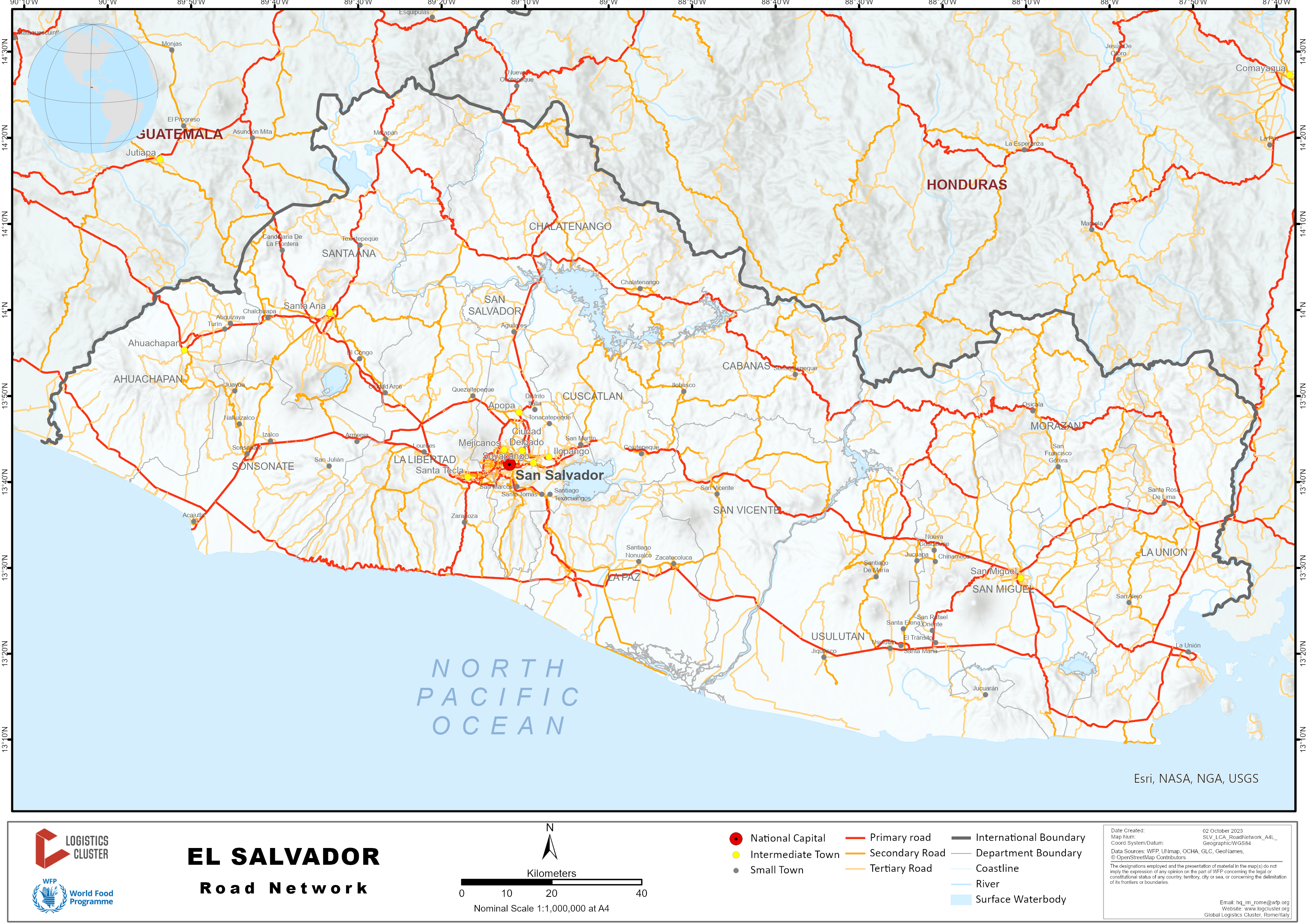
Roads Overview
Intercity Road Network
A network of paved and non paved roads connect the country. The rather good conditions of roads allows for the quick and easy transfer of goods and services from the municipalities to departmental capitals, ports, airports, borders, and regional roads that cross over the country. The execution of studies and projects are carried out through companies contracted by the MOP.
The Ministry of Public Works (MOP) is responsible for the planning, improvements and construction of the country’s road network. Maintenance of primary roads are carried out by private companies and paid with from the Road Maintenance Fund (FOVIAL).
Urban Road Network
This network consists of Urban Road Corridors that have high traffic. Urban roads enable connectivity within cities and with the intercity road network in such a way that facilitates economic, trade, educational, industrial and social activities in cities. This network is maintained by FOVIAL and MOP. The execution of studies and projects are carried out through companies contracted by the MOP.
El Salvador Road Maps are available in the following Annexes:
Annex VII El Salvador Roads Map (Source FOVIAL)
Annex XXII Road Map general information
For more information, please see the following link: 4.1 El Salvador Government Contact List
Road Construction/Maintenance
FOVIAL is responsible for maintenance of the national road network as such, a series of preventive and corrective maintenance activities are carried out every year to avoid sudden deterioration of roads caused by vehicle use and the natural elements like rain.
FOVIAL's main activities include:
• Surface Treatment:
- Stamps
- Irrigation of grout asphalt, micro surfacing
- Other types of treatments
• Renewal of the surface:
- Recycling
- Asphalt binder re-installation
• Stabilization bases
• Renewal shoulders
• Construction of drainage longitudinal
• Construction of cross drainage
• Placement signaling horizontal
• Placement signaling Vertical
• Placing Flex Beam
• Clean drainage longitudinal
• Clean drainage transverse
Distance Matrix
Road Security
Road security in El Salvador is classified as Marginal.
Weighbridges and Axle Load Limits
There is a weighbridge at Km 2 from Acajutla to San Salvador to control the trucks coming from the Port.
For more information, please see the following link: Annex XXIII Tabla de pesos y medidas
Road Class and Surface Conditions
|
Classification |
Road Description |
|---|---|
|
Class: Paved principal roads |
Intercity roads which support permanent transit and allow access to main urban areas. |
|
Class: Improved roads |
Municipal connections with the network of paved roads. The roads that ensure municipal interconnection. The roads that connect agriculture centers, livestock and cooperatives. |
|
Class: Summer transit |
Are established by law, such as temporary roads, that due to the surface conditions are impassable during the rainy season. |
|
Class: Urban roads |
Urban roads in the main city centers; generally well paved and maintained at an average standard. |
|
Class: Foot Print roads |
These are roads that can be accessed only on foot or using animal traction. |
Road Inventory
|
Classification |
Administering Agency |
Network Length |
|---|---|---|
|
Paved principal road |
MOP-Fovial |
3,247 km |
|
Unpaved road |
MOP-Fovial |
3,671 km |
|
Improved roads |
MOP-Fovial |
7,983 km |
|
Summer transit |
MOP-Fovial |
10,431 km |
|
Foot print roads |
MOP-Fovial |
9,687 km |
|
Urban roads |
MOP-Fovial |
2,094 km |
Bridges
El Salvador has not erected several complex bridge structures. Outside the capital there are bridges that pass over rivers and have some important vehicle flow. There are two major bridges in the country:
- San Marcos Lempa Bridge (found on Highway CA-2) with a length of 700 meters and draft of 17.7 meters. Its construction costs amounted to US $25 million dollars and built in three years.
- The Pan American Highway Bridge (found on Highway CA-1) which spans 400 meters in length.
A list of Bridges in areas with high floods risk can be found in Annex II Bridges in areas with high floods risk.
International corridors leading to the Country
The foundation to develop and intertwine logistics and transport has come about with the construction of the Union Port. The notion of networking a road system around the Port would facilitate the transport of international cargo from the port to various cities in El Salvador.
As part of the Plan Puebla-Panama accords, six international corridors have been incorporated and enabled, from which three of them are in El Salvador:
- Port Union–Port Cortés
- La Libertad-Poy-San Pedro Sula (“Canal Seco”)
- Acajutla-Anguiatu-Rio Hondo-Guatemala International Inter-oceanic
Main corridors within the Country (leading to main towns / hubs)
El Salvador is a transit point for passengers and freight transport travelling from North to South America or vice versa. The Pan-American Highway passes through El Salvador and connects the capital, San Salvador, with land borders with Guatemala and Honduras. Two other major roads are the Coastal Highway, built in the 50's, which runs parallel to the coast of the Pacific Ocean and the North Trunk Road, which connects the capital with the department of Chalatenango.
El Salvador - 2.4 Railway Assessment
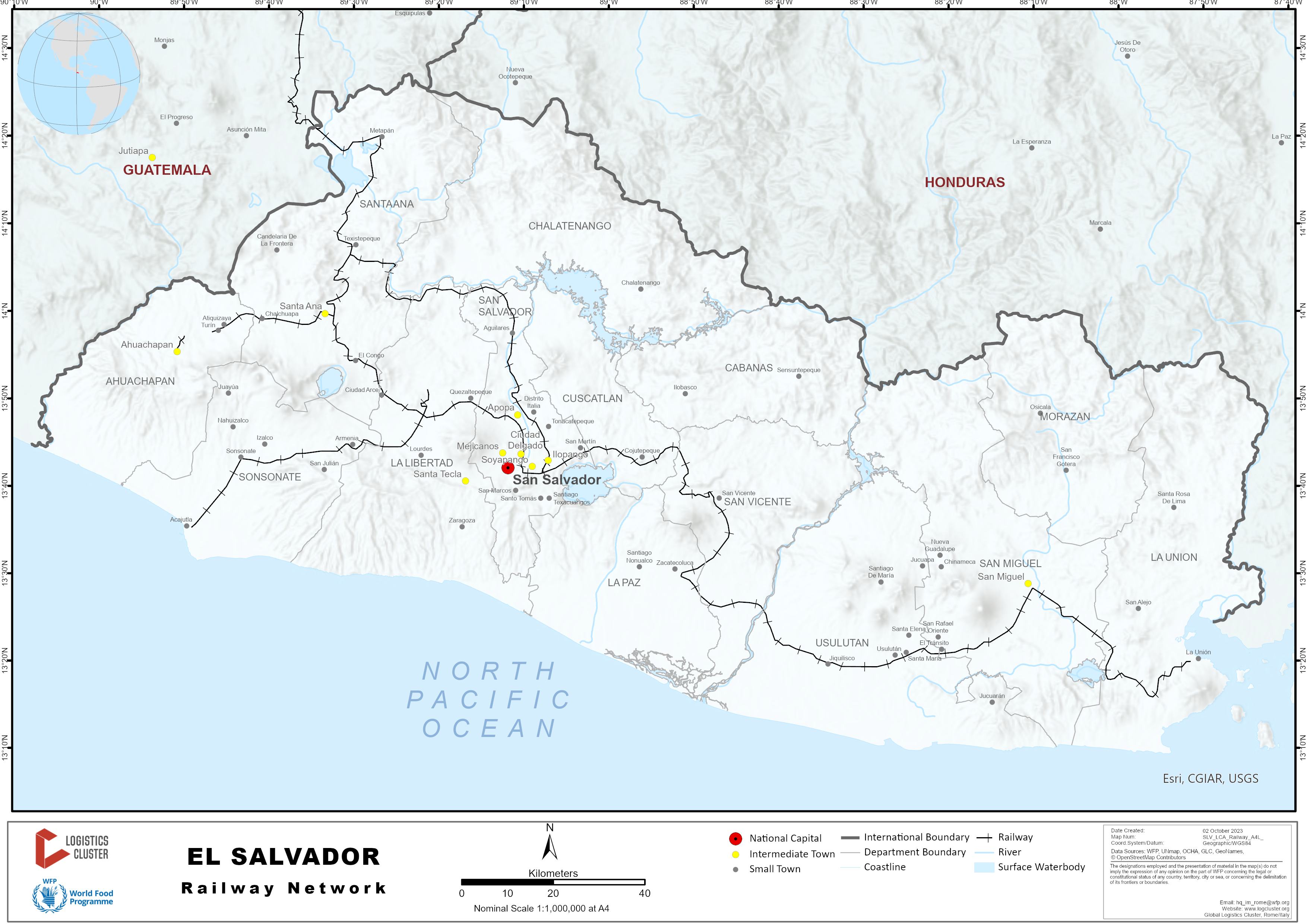
Railway Companies and Consortia
The private railway that exists in country had been out of service since 2002. The rail was revived in 2007 for the use of public transportation. The railway has brought a significant savings in transportation fees for low income families, who travelled between the municipalities of San Salvador, Ciudad Delgado and Apopa. A passenger train ticket with the El Salvador National Railways (FENADESAL) costs only US$ 0.10 cents. Not only passengers have benefited from the reopening of rail service, but also many people who are engaged in informal trade, selling edible products inside the carriages every day, while the train runs through the districts mentioned above. The Government is determining the feasibility to expand the service to the borders in order to support the supply chain of trade in the region, through the interconnection of the railway network with Honduras and Guatemala, and to ensure and promote the national vision to turn El Salvador into a center for value-added regional distribution. The total track distance is 283 Km.
Connections:
- Union Port – Apopa town
- Apopa town – Port of Acajutla
- Apopa town - Guatemalan border
- Town of San Jerónimo (El Salvador border) – Zacapa town – Port Barrios
For more information, please see the following links:
4.1 El Salvador Government Contact List
4.10 El Salvador Railway Company Contact List
Stations/Dry Ports
There are no dry ports in El Salvador, but Honduras has begun construction in 2008 of its stage of the "Dry Canal", the Central American inter-ocean highway. The project is backed by the Central American Bank for Economic Integration (BCIE). The 100-kilometer route is to link Goascorán, on the border with El Salvador, with Villa de San Antonio in central Honduras. The Dry Canal aims to link the Pacific ports of La Unión (El Salvador), Henecán (Honduras) and Corinto (Nicaragua) with the Caribbean ports of Puerto Cortés (Honduras) and Puerto Barrios (Guatemala).
El Salvador - 2.5 Waterways Assessment
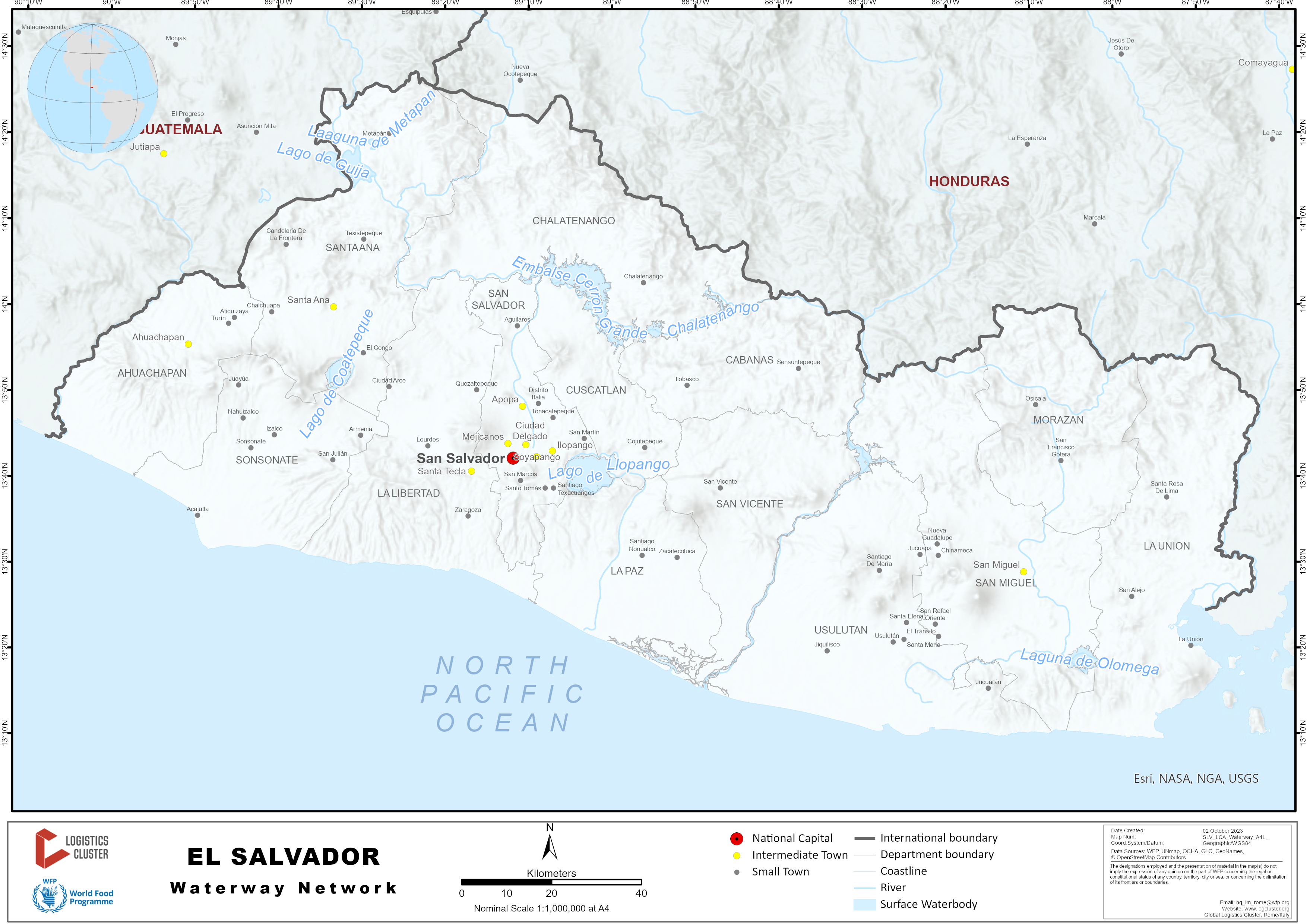
Waterways Overview
Commercial navigation along the rivers of El Salvador is almost nonexistent. The country's largest river, Rio Lempa, connects a network of over 150 smaller streams that are used for local transportation and commerce. The river is navigable only through short disconnected segments, by small shallow draft vessels.
The country has four large river basins and seven smaller river basins that drain the Pacific Coastal Cordillera. The four large river basins are:
- Rio Lempa basin
- Rio Goascoran basin
- Rio Grande de San Miguel basin
- Rio Paz basin
The Rio Lempa is the largest and most important river in El Salvador with its basin covering an area of 18,246 square kilometers (km2). Of this area, 10,255 km2 are in El Salvador, 5,696 km2 are in Honduras, and 2,295 km2 are in Guatemala. The Rio Lempa is also the largest river system in Central America with its water used mainly for hydroelectric power. As mentioned previously, there are three significant manmade reservoirs on the Rio Lempa which store enormous quantities of water for hydroelectric power generation. They are the Embalse Cerron Grande (135 km2 surface area), Embalse Presa Cinco de Noviembre (20 km2 surface area), and Embalse Quince de Septiembre, also called Embalse del San Lorenzo (35 km2 surface area). In addition, the Embalse del Guajoyo is a small reservoir on the Rio Desague in northwestern El Salvador that is also used for hydropower. Discharges from the reservoirs control the flow of the Rio Lempa. The average flow of the Rio Lempa is about 153 cubic meters per second (m3/s) from the Embalse Cerron Grande reservoir, about 197 m3/s from the Embalse Presa Cinco de Noviembre reservoir, about 329 m3/s at the Rio Torola confluence, and about 362 m3/s at the Cuscatlan Bridge on the Pan American Highway. The Rio Lempa receives domestic and industrial wastes from population located along its western margin and a high concentration of sediments from deforested zones along the eastern margin.
The seven smaller basins are:
- The coastal area between the Rio Cara Sucia and Rio Copinula;
- The coastal area between the Rio Sensunapan and Rio Banderas;
- The coastal area between the Rio Pululuya and Rio Comalapa;
- The Rio Jiboa basin;
- The coastal area between the Rio Jalponga and Rio El Guayabo;
- The coastal area between the Rio El Potrero and Rio El Molino; and
- The coastal area between the Rio Grande de San Miguel and Rio Sirama.
All rivers in El Salvador eventually discharge into the Pacific Ocean.
El Salvador has four main lakes:
- Lake Coatepeque, the largest, is a volcanic lake located 18 km south of the city of Santa Ana. It covers an area of 24 km2 and has a depth of 115 meters. Lake Coatepeque is also located at an altitude of 745 meters.
- Güija Lake, shared between El Salvador and Guatemala, is located in the northwest border of El Salvador and east of Guatemala. It is located at an altitude of 430 meters above sea level and covers an area approximately 45 km2.
- Lake Ilopango, of volcanic origins, measures 72 km2 and constitutes one of the largest water reserves and a beauty of El Salvador. Located 16 km from San Salvador and 440 meters above sea level, it reaches depths of 230 meters.
- Lake Olomega has the largest reserve of fresh water. Its length is 24.2 km2 and is located 15 kilometers southeast of San Miguel. It is fed and drained by the Rio Grande of San Miguel and its current state is eutrophication. Its jurisdiction is shared by the municipalities of Chirilagua (San Miguel) and El Carmen (La Union).
For more information, please see the following link: 4.1 El Salvador Government Contact List
Port Information
There are no important river/lake ports in country.
El Salvador - 2.6 Storage Assessment
Storage Overview
Public and private storage & warehouse facilities in El Salvador are quite acceptable with a range of options available nationwide. WFP used 3 warehouses from 2005 until 2014; which were owned and run by WFP’s Government Counterpart, the Food Assistance Directorate of the Secretariat for Social Inclusion (SIS/DAA). Currently WFP’s making use of one warehouse known as BFA Sitio del Niño. Warehouse staff is skilled with extensive knowledge on warehouse management, commodity handling, conservation techniques as well as WFP operating procedures. Insecticides for fumigation, (phosphine) gases are stored on site and can be purchased locally without difficulty. The staff has been trained on the use of fumigants and insecticides, safety measures etc. All warehouses used for the storage of WFP commodities are fixed structures, and not pre-fabricated (i.e. Wiikhall are currently used for WFP operations).
Therefore, WFP directly manages this BFA-Sitio del Niño warehouse, which is also on Government property (Banco de Fomento Agropecuario) and its management is shared between WFP and SIS/DAA.
For more information, please see the following link: 4.6 El Salvador Storage and Milling Company Contact List
Commercial Storage
The private storage & warehouse conditions in El Salvador are quite acceptable with a range of options available nationwide. The companies offer a variety of services such as warehouses with ample storage capacity, and logistics services, i.e., freight forwarding and distribution of goods. Cost of commercial warehousing ranges between 6 and 13 USD/MT/month (accessories services, like handling and fumigation are excluded).
|
Location |
Owner |
Available for Rent |
Capacity |
Type [1] |
Access [2] |
Condition [3] |
|---|---|---|---|---|---|---|
| Styba Storage and Services Blv.Pynsa Calle L-2 Zona Industrial Merliot Ant.Cuscatlán La libertad |
Styba Storage and Services S.A. de C.V. | Yes | Five industrial buildings with 17,000 m³ | Storage and Logistics services | Flat | Good |
| Carretera a Santa Ana Km27 ½ Crío La Arenera, El Salvador | Almacena S.A. de C.V. | Yes | 14,300 m³ | Storage and logistics services | Flat | Good |
| Nueva carretera Panamericana CA-1 Cantón joya Galana apopa-El Salvador | Ransa El Salvador | Yes | 17,000 m³ | Storage and Logistics Services | Flat | Good |
|
K11 Road to La Libertad Port, La Libertad, El Salvador |
Bodesa Prologix
|
Yes | Warehousing, logistics, custom services | Raised Siding | Good | |
|
Edif. 15 Norte. EXPORT SALVA FREE ZONE.
Km. 24 carretera a Santa Ana, Municipio de Colon, La Libertad |
Blue Logistics | Yes | Warehousing, logistics, custom services | |||
[1] Warehouse Type: Open storage, container, rub-hall, silo, concrete, other, unspecified
[2] Warehouse Access: Raised-siding, flat
[3] Warehouse condition: Appears intact, appears damaged, under construction/repair
Storage Used by Humanitarian Organizations
| Location | Organization |
Sharing Possibility |
Capacity |
Type [1] | Access [2] | Condition [3] |
|---|---|---|---|---|---|---|
| Zapotitán warehouse is located Carretera hacia Santa Ana Kilómetro 32 ½ | División de Asistencia Alimentaria (DAA) Secretaría de Inclusión Social (SIS), Zapotitán |
Yes | 10,000 m2 | Concrete | Raised siding | Good |
|
Santa Ana warehouse is 75 km to the west of the capital and |
División de Asistencia Alimentaria (DAA) Secretaría de Inclusión Social (SIS), Zapotitán |
Yes | 10,000 m2 | Concrete | Flat | Good |
|
San Miguel warehouse is 120 km to the east of the capital and 65 km from the Honduran border of El Amatillo: |
División de Asistencia Alimentaria (DAA), Secretaría de Inclusión Social (SIS), San Miguel Warehouse |
Yes | 6,500 m2 | Concrete | Flat | Good |
| Bodegas BFA Sitio del Niño, Km. 29 carretera hacia Santa Ana, Desvío a San Juan Opico, Departamento de la Libertad |
PMA/División de Asistencia Alimentaria (DAA) Secretaría de Inclusión Social (SIS) |
Yes | 4,000 m2 | Concrete | Flat | Good |
| Segunda Brigada Aerea, Municipio de San Luis Talpa, Depto. de La Paz | PMA | Yes | 320 m2 | WiikHall | Flat | Good |
| Bodegas ASIC Cabañas, San Isidro, Km 70 carretera a Sensun tepeque, Col. Chavez | Asociación Amigos de San Isidro Cuscatlan (ASIC) | Yes | 665 m2 | Concrete | Flat | Good |
[1] Warehouse Type: Open storage, container, rub-hall, silo, concrete, other, unspecified
[2] Warehouse Access: Raised-siding, flat
[3] Warehouse condition: Appears intact, appears damaged, under construction/repair
Public Sector Storage
| Location | Ministry / Agency |
Use Possibility |
Capacity |
Type [1] | Access [2] | Condition [3] |
|---|---|---|---|---|---|---|
|
El Salvador International Airport is located in the South Central area of the country in the department of La Paz, limiting the South to the Pacific Ocean, to the east with the Jiboa River, and with the North West Coastal Highway |
CEPA | Yes | 10,000 m2 | Concrete | Flat | Good |
|
Port of Acajutla, The Port of Acajutla is located in the department of Sonsonate |
CEPA | Yes | 4 W/Hs with storage capacity of 22,600 m2, and two roofing modules with a storage capacity of 6,122 m2. One container yard of 30,000 m2, W/H of bulk solids for export (12k MT) and one W/H of bulk solid for import (18k MT) |
Concrete | Flat | Good |
| Bodegas BFA Sonsonate, Acajutla, Km 81 carretera a Acajutla | Banco de Fomento Agropecuario (BFA) | Yes |
5,000 m2 |
Concrete |
Flat |
Good |
| Bodegas BFA Cuscatlan, El Rosario, San Rafael Cedro Km 45.5 carretera a Ilobasco, Cton. Cerro Colorado |
Banco de Fomento Agropecuario (BFA) | Yes |
5,700 m2 |
Concrete |
Flat |
Good |
| Bodegas BFA SIRAMA, La Union km 177.5 Carretera a la frontera El Amatillo |
Banco de Fomento Agropecuario (BFA) | Yes |
2,640 m2 |
Concrete |
Flat |
Good |
| Bodega ex-IRA en San Vicente Km 55.5 carretera a S. Vicente, Cton. Las Minas |
Ministerio de Hacienda | Yes |
200 m2 |
Metal |
Flat |
Needs services connections |
| Bodega ISTA Usulutan, Av. Gerson Calito, Centro de Gobierno | ISTA | Yes | 270 m2 |
Concrete |
Flat |
Good |
[1] Warehouse Type: Open storage, container, rub-hall, silo, concrete, other, unspecified
[2] Warehouse Access: Raised-siding, flat
[3] Warehouse condition: Appears intact, appears damaged, under construction/repair
Cold Chain
|
Location |
Organisation / Owner |
Type [1] |
Cooling / Power [2] |
Quantity |
Total Capacity |
Condition |
|---|---|---|---|---|---|---|
|
Km 27.5 Carretera a Santa Ana, San Juan Opico La libertad |
ALMACENA SA DE C.V. |
Concrete |
Frozen |
1 |
14,300 (Frozen Warehouses) |
Good |
|
Km 27.5 Carr. a S. Ana, S. Juan Opico, LLtad |
ALMACENA S.A. DE C.V. |
Concrete |
Chilled |
1 |
150 m2(chilled warehouses) |
Good |
|
Blvd. Pynsa, Calle L-2, Zona Industrial Merliot, Antiguo Cuscatlan, San Salvador |
STYBA |
Concrete |
Frozen |
1 |
3,000 m2 |
Good |
|
Blvd. Pynsa, Calle L-2, Zona Industrial Merliot, Antiguo Cuscatlan, San Salvador |
STYBA |
Concrete |
Chilled |
1 |
3,000 m2 |
Good |
|
Nueva carretera Panamericana CA-1 Cantón joya Galana apopa-El Salvador |
RANSA |
Concrete |
Chilled |
1 |
5,400 m2 |
Good |
[1] Cold Room Positive, Cold Room Negative, Refrigerator, Freezer,
[2] Compression, Absorption, Solar, Other, unspecified
El Salvador - 2.7 Milling Assessment
Milling overview
Currently, there are two large mills in El Salvador. HARISA from Grupo Molinos Modernos and MOLSA, Molinos de El Salvador. In recent years, these wheat mills have diversified their products.
MOLSA SA DE CV
MOLSA is a wheat flourmill located in the capital, San Salvador,. It is considered the largest producer of wheat flour for bread industry and associated products are biscuits. Was founded in April 1959.
HARISA SA DE CV
Was founded in April 1963. Another large mill located in the LA LAGUNA industrial zone, in the metropolitan area of San Salvador. A very diversified mill in flour for bakery, flour for pasta, corn flour and cookies. Its market ranges from Mexico, Central America and the Caribbean.
Other distributors and processing companies
|
Distributor |
Products |
|
Arrocera OMOA 32 Avenida Norte No. 405, Barrio Lourdes San Salvador, El Salvador C.A Teléfonos: (503) 2221-6047 y (503) 2440-0548 Fax: (503) 2221-2251 y (503) 2221-2250 Email. info@arroceraomoa.com |
Produce rice, beans and rice flower |
|
Arrocera San Francisco Kilometro 9 1/2, Carretera a Comalapa, San Marcos El Salvador, Centro América Tel. +503 2213 1115 Atención Al Cliente: (503) 2213-1140 |
Rice and cereals producers. Also distribute other products and brands: Kimberly Clark, Red Bull, Cerveza Hollandia, Snacks PRO, Liquid food Silk, Pozuelo, 3M, Underwood, among other brands.
|
|
DIANA 12 Ave. Sur, #111, Colonia Guadalupe, Soyapango, Apartado Postal 177, San Salvador, El Salvador Tel. +503 2277 1233, |
Produce bicuits and snacks. |
|
Nestlé Centroamérica Edif Ctro Corporativo Madre Selva Av El Espino y Calzada El Almendro Santa Tecla - La Libertad Tel. 503 2288 8400 |
Produces children’s cereals, drinks and milk. |
|
COMALI FOODS http://www.comalifoods.com/es/index.html Calle L-3 Boulevard Si-Ham, pol. A-19, Zona Industrial Merliot, Antiguo Cuscatlan, La Libertad, El Salvador. Te. + 503 2278-8250/51 |
Produce food ready to eat (tamales, rice and beans, fried beans, pasta, etc.) |
|
Alimentos S.A (Central de Alimentos S.A.) 24 ave. 19-67, zona 12, entrada por "El Cortijo I", Guatemala C.A. Teléfono: +502 2422 7000 / +502 2422 7070 escribeme@icasa.com.gt Email: alanayapan@icasa.com.gt |
fortified drinks, oats, Cereals, Salty snacks, Corn chips, Soy protein, Corn flour and semolina, Corn Grits, Pre-cooked Corn Flours |
Other suppliers
PAMEM, S.A. de C.V. (arroz, frijol) (Arrocera Jerusalén, S.A. de C.V.)
Phone: 2278-4279, 7862-7053
Pedro Antonio Menjívar Rivera
La Fabril de Aceites, S.A. de C.V.
Phone: 2476-0776, 7682-6429, 7841-6130 7844-8952
mdjm@lafabril.com.sv ; ocruz@lafabril.com.sv ; vilmaumana@lafabril.com.sv
Manuel Montes, Vilma Umaña
Summa Industrial, S.A. de C.V. (aceites)
Phone: 2476-0776, 7682-6430, 7870-3206 7850-1758
ralas@summa.com.sv ; ventasumma@summa.com.sv; roxanaarrue.alas@hotmail.com
Roxana de Alas
